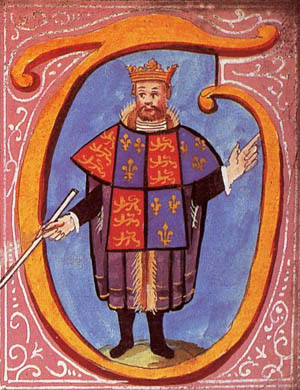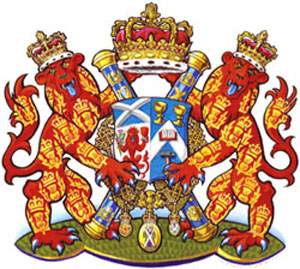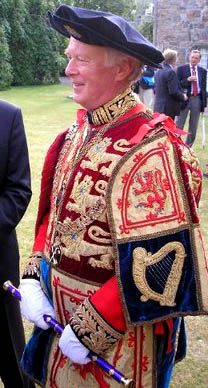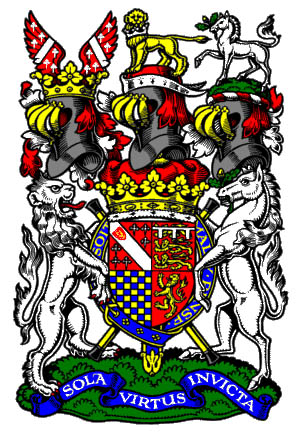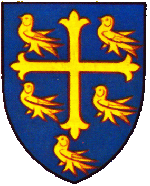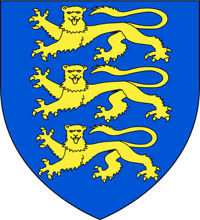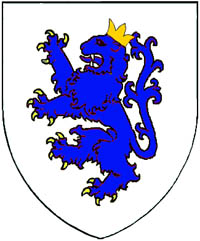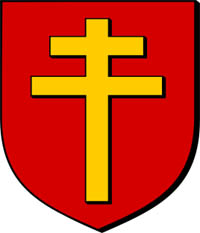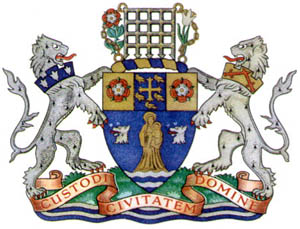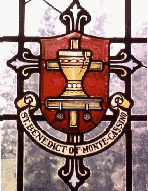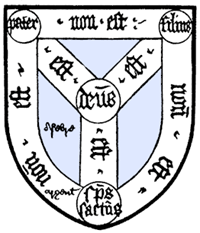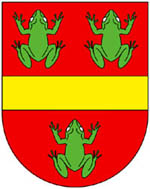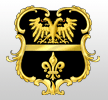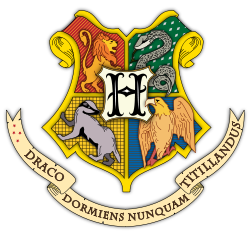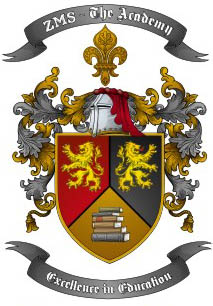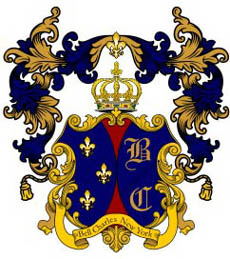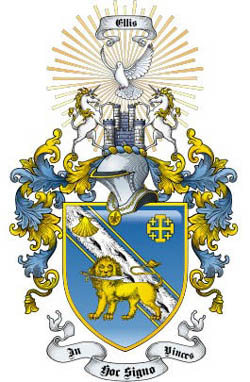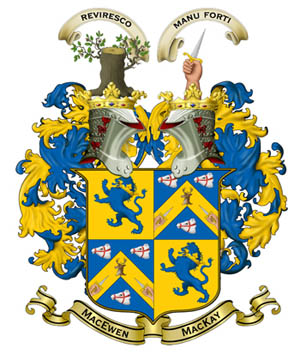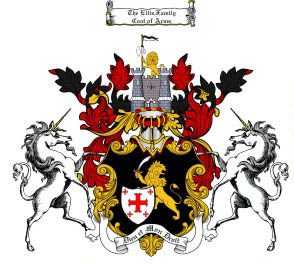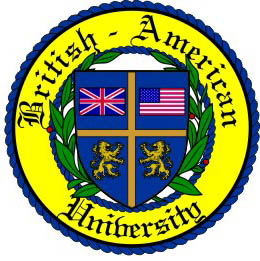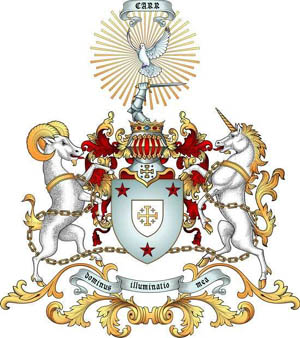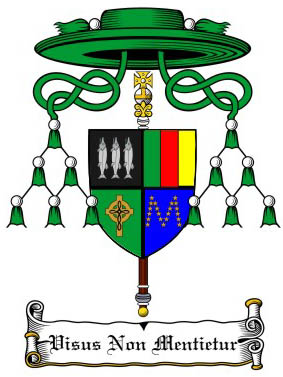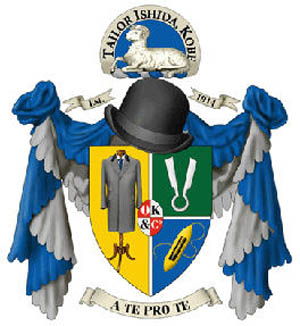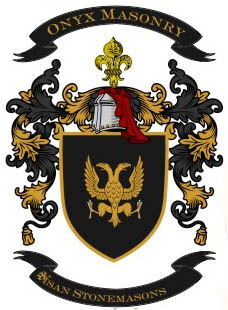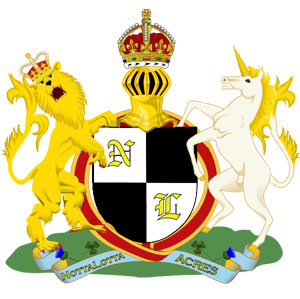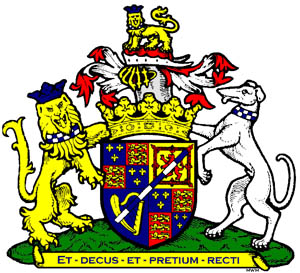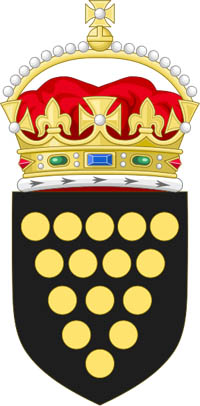International Heraldry & Heralds |
| HOME | MY ARMS / GENEALOGY | NATIONAL HERALDRY | HATCHMENTS | EXAMPLES | HERALDRY BOOKS | FAQs |
|
|
|
|
|
|
||||||||||||||||||||||||||||||||||||||||||||||||||||||||||||||||||||||||||||||||||||||||||||||||||||||||||||||||||||||||||||||||||||||||||||||||||||||||||||||||||||||||||||||||||||||||||||||||||||||||||||||||||||||||||||||||||||||||||||||||||||||||||
|
|
Heraldry is the practice of devising, granting, displaying, describing, and recording coats of arms and heraldic badges. Officers of arms (Kings of Arms, Heralds and Pursuviants) practice heraldry and also rule on questions of rank or protocol.
Truly heraldic devices seem to have been first used in Carolingian times. Seals and banners confirm that they were being used in the Flemish area of Europe during the reign of Charlemagne (768–814 AD). The emergence of heraldry as we know it today was linked to the need to distinguish participants quickly and easily in combat. Distinguishing devices were used on surcoats ("coats of arms"), shields, and caparisoned horses, and it would have been natural for knights to use the same devices as those already used on their banners and seals. A formal system of rules developed into ever more complex forms of heraldry to ensure that each knight's arms were unique (at least within the same jurisdiction). The system of blazoning arms that is used in English-speaking countries today was developed by the officers of arms in the Middle Ages. This includes a stylised description of the escutcheon (shield), the crest, and, if present, supporters, mottoes, and other insignia. The language is an anglicised version of Norman French and does not always match modern heraldic French: for example the colour green is called Vert in heraldic English, but sinople in heraldic French. Although heraldry is nearly 900 years old, it is still in use. Many cities and towns in Europe and around the world make use of arms. Personal heraldry, both legally protected and lawfully assumed, has continued to be used around the world. Certain heraldic rules apply, the most important of which is the Rule of Tincture. This prohibits certain colour combinations, as described below. Understanding these rules is a key to the art of heraldry. Rules and terminology differ from country to country. Several national styles had developed by the end of the Middle Ages, but some aspects carry over internationally.
|
|||||||||||||||||||||||||||||||||||||||||||||||||||||||||||||||||||||||||||||||||||||||||||||||||||||||||||||||||||||||||||||||||||||||||||||||||||||||||||||||||||||||||||||||||||||||||||||||||||||||||||||||||||||||||||||||||||||||||||||||||||||||||||||
|
|
||||||||||||||||||||||||||||||||||||||||||||||||||||||||||||||||||||||||||||||||||||||||||||||||||||||||||||||||||||||||||||||||||||||||||||||||||||||||||||||||||||||||||||||||||||||||||||||||||||||||||||||||||||||||||||||||||||||||||||||||||||||||||||||
Shield and Lozenge
EscutcheonIn heraldry, an escutcheon, or scutcheon, is the shield displayed in a coat of arms. The escutcheon shape is based on the Medieval shields that were used by knights in combat. The shape varied from region to region and over time. The shield is used in heraldry not only for men but corporate bodies: city corporations, universities and schools, companies, churches and for various official offices.
As women did not go to war, they did not bear a shield. Instead, their arms were shown on a lozenge — a rhombus standing on one of its acute corners or a cartouche. This continues in much of the world, though some heraldic authorities, notably Scotland, uses ovals for women's arms. In England, Scotland and Ireland, women may, in certain circumstances, display their arms on a shield. In Canada, the restriction against women's bearing arms on a shield has been abrogated. Noncombatant clergy also have used the lozenge and the cartouche or an oval for their armorial display.
The following are the points of the shield used in blazons to describe where a charge should be drawn:
InescutcheonAn inescutcheon is a smaller shield that is shown within or superimposed over the main shield. This may be used for heraldic style, in pretence (to bear another's arms over one's own), to bear one's own personal arms over the territorial arms of one's domains, as an augmentation of honour, or as a simple charge. Inescutcheons may also be used to bear another's arms in "pretence", In English Heraldry the husband of a heraldic heiress - a woman without any brothers - may place her father's arms in an escutcheon of pretence in the centre of his own shield as a claim ("pretence") to be the head of his wife's family. In the next generation the arms would then be quartered. (Normally the arms of the wife would be impaled with those of the husband a convention known as Baron and Femme).
On the right are the arms of George IV His arms, when King, were: Quarterly, I and IV Gules three lions passant guardant in pale Or (for England); II Or a lion rampant within a tressure flory-counter-flory Gules (for Scotland); III Azure a harp Or stringed Argent (for Ireland); overall an inescutcheon tierced in pairle reversed (for Hanover), I Gules two lions passant guardant Or (for Brunswick), II Or a semy of hearts Gules a lion rampant Azure (for Lüneburg), III Gules a horse courant Argent (for Westfalen); on that another inescutheon Gules, Charlemagne crown Or (Elector of Hanover); the whole inescutcheon surmounted by a crown. Inescutcheons also appear in personal and civic armory as simple common charges, such as in the arms of Portugal or the Swedish Collegium of Arms which bears the three crowns of Sweden, each upon its own escutcheon within the field of the main shield |
|
|||||||||||||||||||||||||||||||||||||||||||||||||||||||||||||||||||||||||||||||||||||||||||||||||||||||||||||||||||||||||||||||||||||||||||||||||||||||||||||||||||||||||||||||||||||||||||||||||||||||||||||||||||||||||||||||||||||||||||||||||||||||||||||
 |
||||||||||||||||||||||||||||||||||||||||||||||||||||||||||||||||||||||||||||||||||||||||||||||||||||||||||||||||||||||||||||||||||||||||||||||||||||||||||||||||||||||||||||||||||||||||||||||||||||||||||||||||||||||||||||||||||||||||||||||||||||||||||||||
TinctureTinctures are the colours and patterns used in heraldry. In heraldic terms they are divided into standard "colours", "metals", and "furs". The Petra Sancta method was created in 1638 to render colors in black and white images of coats of arms: tinctures are indicated by a hatching convention as shown below, where the dexter half of the shield is coloured and the sinister half hatched to denote the same colour.
Two "metals" are also used:Or and Argent. A new colour, Bleu-celeste, was introduced in the twentieth century
Furs: Certain patterns called "furs" appear in coats of arms. They are defined as tinctures, not patterns. The two common furs are ermine and vair. Ermine represents the winter coat of the stoat, which is white with a black tail. Vair represents a kind of squirrel with a blue-gray back and white belly. Sewn together, it forms a pattern of alternating blue and white shapes.
Ermine
Vair and Potent are common: Countervair and Counterpotent relatively rare. A number of other colours, called stains are used, but are much less common, notably,
These are only occasionally found, typically for special purposes - for example many air forces use Bleu-celeste (sky blue).
Proper charges are very frequent as crests and supporters.
The Rule of Tincture
Where a charge overlies a partition of the field, the rule does not apply. In fact it does not apply in many specific cases (arms divided per pale, impaled arms, brisures). Nor does the rule apply to furs.
|
|
|||||||||||||||||||||||||||||||||||||||||||||||||||||||||||||||||||||||||||||||||||||||||||||||||||||||||||||||||||||||||||||||||||||||||||||||||||||||||||||||||||||||||||||||||||||||||||||||||||||||||||||||||||||||||||||||||||||||||||||||||||||||||||||
|
||||||||||||||||||||||||||||||||||||||||||||||||||||||||||||||||||||||||||||||||||||||||||||||||||||||||||||||||||||||||||||||||||||||||||||||||||||||||||||||||||||||||||||||||||||||||||||||||||||||||||||||||||||||||||||||||||||||||||||||||||||||||||||||
Divisions of the Field
Another way of creating more variations is to vary the field. The field can be divided into more than one tincture. Many coats of arms consist simply of a division of the field into two contrasting tinctures. These are considered divisions of a shield, so the rule of tincture does not apply. For example, a shield divided Azure and Gules would be perfectly acceptable.
A line of partition may be straight or it may be varied. The variations of partition lines can be wavy, indented, embattled, engrailed, nebuly, or other forms.
|
|
|||||||||||||||||||||||||||||||||||||||||||||||||||||||||||||||||||||||||||||||||||||||||||||||||||||||||||||||||||||||||||||||||||||||||||||||||||||||||||||||||||||||||||||||||||||||||||||||||||||||||||||||||||||||||||||||||||||||||||||||||||||||||||||
|
||||||||||||||||||||||||||||||||||||||||||||||||||||||||||||||||||||||||||||||||||||||||||||||||||||||||||||||||||||||||||||||||||||||||||||||||||||||||||||||||||||||||||||||||||||||||||||||||||||||||||||||||||||||||||||||||||||||||||||||||||||||||||||||
Variations of the fieldThe field of a shield, or less often a charge or crest, is sometimes made up of a pattern of colours, or variation. A pattern of horizontal (barwise) stripes, for example, is called barry, while a pattern of Vertical (palewise) stripes is called paly. A pattern of diagonal stripes may be called bendy or bendy sinister, depending on the direction of the stripes. In each case, there are always an even number of stripes, half of one colour and half of the other. (cf palets, bars and bendlets) Other variations include chevrony, gyronny and chequy.
Most small charges can be depicted as semé, e.g. semé of roses, semé of estoiles, and so forth. In English heraldry, several types of small charges have special terms to refer to their state as semé:
In European heraldry fields are sometimes blazoned as Papelonny, which represents fish scales. The term may be written Papelonne, Papilone, or Pampillettée.
Other rare variations of the field include
Variations of the field are sometimes combined to produce patterns of barry-bendy, paly-bendy, lozengy and fusilly Semés, or patterns of repeated charges, are also considered variations of the field.
The Rule of tincture applies to all semés and variations of the field.
|
|
|||||||||||||||||||||||||||||||||||||||||||||||||||||||||||||||||||||||||||||||||||||||||||||||||||||||||||||||||||||||||||||||||||||||||||||||||||||||||||||||||||||||||||||||||||||||||||||||||||||||||||||||||||||||||||||||||||||||||||||||||||||||||||||
|
|
||||||||||||||||||||||||||||||||||||||||||||||||||||||||||||||||||||||||||||||||||||||||||||||||||||||||||||||||||||||||||||||||||||||||||||||||||||||||||||||||||||||||||||||||||||||||||||||||||||||||||||||||||||||||||||||||||||||||||||||||||||||||||||||
Ordinaries & Subordinaries
In the early days of heraldry, very simple bold rectilinear shapes were painted on shields. These could be easily recognized at a long distance and could be easily remembered. They therefore served the main purpose of heraldry—identification. As more complicated shields came into use, these bold shapes were set apart in a separate class as the "honourable ordinaries." Some heraldic writers distinguish between "honourable ordinaries" and "sub-ordinaries". While some authors hold that only nine charges are "honourable" ordinaries, exactly which ones fit into this category is a subject of constant disagreement. The remainder are often termed "sub-ordinaries", and narrower or smaller versions of the ordinaries are called diminutives. One herald says: "The first Honourable Ordinary is the cross," the second is the chief, the third is the pale, the fourth is the bend, the fifth is the fess, the sixth is the inescutcheon, the seventh is the chevron, the eighth is the saltire, and the ninth is the bar, while stating that "some writers" prefer the bordure as the ninth ordinary.
They act as charges and are always written first in blazon. Unless otherwise specified they extend to the edges of the field. Other ordinaries are shown below Most of the ordinaries have corresponding diminutives, narrower versions, most often mentioned when two or more appear in parallel. In English heraldry they have different names such as pallets, bars, bendlets, and chevronels.
French blazon makes no such distinction between these diminutives and the ordinaries when borne singly. Unless otherwise specified an ordinary is drawn with straight lines, but each may be indented, embattled, wavy, engrailed, or otherwise have their lines varied. An easy mistake is to confuse arms featuring pallets, bars or bendlets with (respectively) paly, Barry and bendy arms. The former always have an odd number of stripes and the latter an even number. The former are stripes of one colour on top of a field of another colour. The later are alternating coloured stripes.
|
|
|||||||||||||||||||||||||||||||||||||||||||||||||||||||||||||||||||||||||||||||||||||||||||||||||||||||||||||||||||||||||||||||||||||||||||||||||||||||||||||||||||||||||||||||||||||||||||||||||||||||||||||||||||||||||||||||||||||||||||||||||||||||||||||
|
||||||||||||||||||||||||||||||||||||||||||||||||||||||||||||||||||||||||||||||||||||||||||||||||||||||||||||||||||||||||||||||||||||||||||||||||||||||||||||||||||||||||||||||||||||||||||||||||||||||||||||||||||||||||||||||||||||||||||||||||||||||||||||||
SubordinariesThere is a separate class of charges called sub-ordinaries which are of a geometrical shape subordinate to the ordinary.
The quarter is a rectangle occupying the top left quarter of the field, as seen by the viewer. The canton is a square occupying the left third of the chief (sometimes reckoned to be a diminutive of the quarter). The bordure is a border touching the edge of the field. The orle may be considered an inner bordure: a reasonably wide band away from the edge of the shield, it is always shown following the shape of the shield, without touching the edges. The tressure is a narrower version of the orle, rarely seen except in the double tressure flory and counter-flory, an element of the royal coat of arms of Scotland and of many other Scots coats. The fret originally consisted of three bendlets interlaced with three bendlets sinister; Other depictions form the outer bendlets into a mascle through which the two remaining bendlets are woven. Flaunches, flanches or flasks are regions on the sides of the field, bounded by a pair of circular arcs whose centres are beyond the sides of the shield. A label is a horizontal strap, with a number of pendants (called points) suspended from it; the default is three, but any number may be specified. The label is nearly always a mark of cadency in British and French heraldry, but is occasionally found as a regular charge.
|
|
|||||||||||||||||||||||||||||||||||||||||||||||||||||||||||||||||||||||||||||||||||||||||||||||||||||||||||||||||||||||||||||||||||||||||||||||||||||||||||||||||||||||||||||||||||||||||||||||||||||||||||||||||||||||||||||||||||||||||||||||||||||||||||||
 |
||||||||||||||||||||||||||||||||||||||||||||||||||||||||||||||||||||||||||||||||||||||||||||||||||||||||||||||||||||||||||||||||||||||||||||||||||||||||||||||||||||||||||||||||||||||||||||||||||||||||||||||||||||||||||||||||||||||||||||||||||||||||||||||
Charges
A charge is any object or figure placed on a heraldic shield or on any other object of an armorial composition. Any object found in nature or technology may appear as a heraldic charge in armory. Charges can be animals, objects, or geometric shapes. Apart from the ordinaries, the most frequent charges are the cross—with its hundreds of variations—and the lion and eagle. Other common animals are stags, wild boar, martlets, and fish. Dragons, bats, unicorns, griffins, and more exotic monsters appear as charges and as supporters. Animals are found in various stereotyped positions or 'attitudes'. Quadrupeds can often be found rampant—standing on the left hind foot. Another frequent position is passant, or walking, like the lions of the coat of arms of England. Eagles are almost always shown with their wings spread, or displayed. In English heraldry the crescent, mullet, martlet, annulet, fleur-de-lis, and rose may be added to a shield to distinguish cadet branches of a family from the senior line. These cadency marks are usually shown smaller than normal charges, but it still does not follow that a shield containing such a charge belongs to a cadet branch. All of these charges occur frequently in basic undifferenced coats of arms. The term charge can also be used as a verb; for example, if an escutcheon bears three lions, then it is said to be charged with three lions; similarly, a crest or even a charge itself may be "charged", such as a pair of eagle wings charged with trefoils (e.g. Coat of arms of Brandenburg). So-called mobile charges are not tied to the size and shape of the shield, and so may be placed in any part of the field, although whenever a charge appears alone, it is placed with sufficient position and size to occupy the entire field. Common mobile charges include human figures, human parts, animals, animal parts, mythical creatures (or "monsters"), plants and floral designs, inanimate objects and other devices. The heraldic animals need not exactly resemble the actual creatures.
The roundel is a solid circle, frequently of gold, though it can be of any colour. Roundels have their own special names depending on the colour, as shown below.
A fountain is a roundel Barry wavy Argent and Azure. Several other simple charges occur with comparable frequency. These include the mullet or star, crescent and cross. The mullet (or mollet) is a star of (usually five) straight rays, and may have originated as a representation of the rowel or revel of a spur (although "spur-revels" also appear under that name). Mullets frequently appear pierced. If unpierced, it is sometimes called a "star" in Scottish heraldry, and stars also appear in English and continental heraldry under that name (often with six points).
The crescent, a symbol of the Moon, normally appears with its horns upward; if its horns are to Dexter it represents a waxing moon (increscent), and with horns to sinister it represents a waning moon (decrescent). One of the most frequently found charges in heraldry, if not the most, is the cross, which has developed into, some say, 400 varieties. When the cross does not reach the edges of the field, it becomes a mobile charge. The plain Greek cross (with equal limbs) and Latin cross (with the lower limb extended) are sometimes seen, but more often the tip of each limb is developed into some ornamental shape. The most commonly found crosses in heraldry are shown below.
In English heraldry the crescent, mullet, martlet, annulet, fleur-de-lis and rose may be added to a shield to distinguish cadet branches of a family from the senior line. It does not follow, however, that a shield containing such a charge belongs to a cadet branch. All of these charges occur frequently in basic (undifferenced) coats of arms. Humans, deities, angels and demons occur more often as crests and supporters than on the shield. When humans do appear on the shield, they almost always appear affronté (facing forward), rather than toward the left like beasts. The largest group of human charges consists of saints, often as the patron of a town. Knights, bishops, monks and nuns, kings and queens also occur frequently. . Greco-Roman mythological figures typically appear in an allegorical or canting role. Angels very frequently appear.
Plants are common in heraldry and figure among the earliest charges. Trees also appear in heraldry; the most frequent tree by far is the oak (drawn with large leaves and acorns), followed by the pine. Apples and bunches of grapes occur very frequently, other fruits less so. The most famous heraldic flower (particularly in French heraldry) is the fleur-de-lis, which is often stated to be a stylised lily, though despite the name there is considerable debate on this. The "natural" lily, somewhat stylised, also occurs, as (together with the fleur-de-lis) in the arms of Eton College. The rose is perhaps even more widely seen in English heraldry than the fleur-de-lis. Its heraldic form is derived from the "wild" type with only five petals. The thistle frequently appears as a symbol of Scotland. The trefoil, quatrefoil and cinquefoil are abstract forms resembling flowers or leaves. The trefoil is always shown slipped (i.e. with a stem), unless blazoned otherwise. The cinquefoil is sometimes blazoned fraise (strawberry flower), most notably when canting for Fraser. The trillium flower occurs occasionally in a Canadian context, and the protea flower constantly appears in South Africa, since it is the national flower symbol, the South African cricket team sometimes being called the Proteas. Wheat occurs in the form of "garbs" or sheaves and in fields , though less often as ears- all of which are shown unwhiskered. Ears of rye are depicted exactly as wheat, except the ears droop down and is probably best shown as whiskered. Barley, maize and oats also occur.
The moon "in her plenitude" (full) sometimes appears, distinguished from a roundel Argent by having a face; but crescents occur much more frequently. Estoiles are stars with six wavy rays, while stars (when they occur under that name) normally have five straight rays, being the same as the mullet. Clouds often occur, though more frequently for people or animals to stand on or issue from than as isolated charges. The raindrop as such is unknown, though a drop of fluid (goutte) is known. These occasionally appear as a charge, but more frequently constitute a field semé (known as goutté). The oldest geological charge is the mount, typically a green hilltop rising from the lower edge of the field, providing a place for a beast, building or tree to stand.. Natural mountains and boulders are not unknown, though ranges of mountains are differently shown. An example is the arms of Edinburgh, portraying Edinburgh Castle atop Castle Rock. Volcanos are shown, almost without exception, as erupting, and the eruption is generally stylised. In the 18th century, landscapes began to appear in armoury, often depicting the sites of battles. For example, Admiral Lord Nelson received a chief of augmentation containing a landscape alluding to the Battle of the Nile. The most frequent building in heraldry is the tower, a tapering cylinder of masonry topped with battlements, usually having a door and a few windows. The canting arms of the Kingdom of Castile are Gules, a tower triple-towered Or (i.e. three small towers standing atop a larger one). A castle is generally shown as two towers joined by a wall, though sometimes as a wall with two towers; the doorway is sometimes blazoned to be shown secured by a portcullis. The portcullis was used as a canting badge by the Tudors ("two-doors"), and has since come to represent the British Parliament.
Civic and ecclesiastical armory sometimes shows a church or a whole town, and cities, towns and Scots burghs often bear a mural crown (a crown in the form of a wall with battlements or turrets) in place of a crown over the shield. Ships of various types often appear; the most frequent being the ancient galley often called, from the Gaelic, a lymphad. Also frequent are anchors and oars. The maunch is a medieval lappeted sleeve, some highly stylized, and looking quite unlike a sleeve and more like a fancifully-written letter M; in French blazon it is said to be called manche mal taillée ("a sleeve badly cut") though modern French blazons seem to be quite happy with plain manche. Spurs also occur, sometimes "winged", but more frequently occurring is the spur-rowel or spur-revel, which is said to more often termed a "mullet of five points pierced" by English heralds. Crowns and coronets of various kinds are constantly seen. The ecclesiastical hat and bishop's mitre are nearly ubiquitous in ecclesiastical heraldry. The sword is sometimes a symbol of authority, as in the royal arms of the Netherlands, but may also allude to Saint Paul, as the patron of a town (e.g. London) or dedicatee of a church. Other weapons occur more often in modern than in earlier heraldry. The mace also appears as a weapon, the war mace, in addition to its appearance as a symbol of authority, plain mace. The globus cruciger, also variously called an orb, a royal orb, or a mound (from French monde, Latin mundus, the world) is a ball or globe surmounted by a cross, which is part of the regalia of an emperor or king, and is the emblem of sovereign authority and majesty. Books constantly occur, most frequently in the arms of colleges and universities, though the Gospel and Bible are sometimes distinguished. Books if open may be inscribed with words.
Words and phrases are otherwise rare, except in Spanish and Portuguese armory. Letters of the various alphabets are also relatively rare. Arms of merchants in Poland and eastern Germany are often based on house marks, abstract symbols resembling runes.
Animals, especially lions and eagles, feature prominently as heraldic charges. Many important differences exist between an animal's natural form and the stylized form given to it in heraldic displays. Many of these differences are apparent in the conventional attitudes (positions) into which heraldic animals are contorted; additionally, various parts of an animal (claws, horns, tongue, etc.) may be differently coloured, each with its own terminology.
The bird most frequently found in coat armory, by far, is the eagle in its various forms, including the ubiquitous eagle displayed, eagles in other poses (such as statant or rising), the demi-eagle (an eagle displayed, shown only above the waist), the double-headed eagle of imperial fame, and a few other forms . Eagles and their wings also feature prominently as crests. The double eagle gained its fame in the arms of the Byzantine, Holy Roman, Austrian, and Russian empires. The martlet, a stylized swallow without feet, is a mark of cadency in English heraldry, but also appears as a simple charge in undifferenced arms.
Animals' heads are also very frequent charges, as are the paw or leg (gamb) of the lion, the wing (often paired) of the eagle, and the antlers (attire) of the stag. Sometimes only the top half of a beast is shown; for example, the demi-lion is among the most common forms occurring in heraldic crests.
Alternatively they may be erased: with the neck showing a ragged edge as if forcibly torn from the body. The arms on the right feature three griffons'; heads erased.
While cabossed heads are shown facing forward (affronté), heads that are couped or erased face Dexter unless otherwise specified for differencing. Heads of horned beasts are often shown cabossed to display the horns, but instances can be found in any of these circumstances.
AttitudeIn heraldry, an attitude is the position in which an animal, fictional beast, mythical creature, human or human-like being is emblazoned as a charge, supporter or crest. The attitude, or position, of the creature's body is usually explicitly stated in English blazon. When such description is omitted, a lion can be assumed to be rampant, a herbivore passant. By default, the charge faces Dexter (left as seen by the viewer); this would be forward on a shield worn on the left arm. In German heraldry, animate charges in the Dexter half of a composite display are usually turned to face the centre. Certain features of an animal are often of a contrasting tincture. The charge is then said to be armed (claws and horns and tusks), langued (tongue), pizzled (penis), attired (antlers or very occasionally horns), unguled (hooves), crined (horse's mane or human hair) of a specified tincture. Many attitudes apply only to predatory beasts and are exemplified by the beast most frequently found in heraldry — the lion. Some other terms apply only to docile animals, such as the doe. Other attitudes describe the positions of birds, mostly exemplified by the bird most frequently found in heraldry — the eagle. Birds are often further described by the exact position of their wings. The term naiant (swimming), is usually reserved for fish but may also apply to swans, ducks or geese.
Additionally, there are positions applying to direction, to indicate variations from the presumed position of any charge. Animals and animal-like creatures are presumed to be shown in profile, facing Dexter (the viewer's left), and humans and human-like beings are presumed to be shown affronté (facing the viewer), unless otherwise specified in the blazon. To sinister or contourné is said of an animal or being that is turned to face the viewer's right. Guardant indicates an animal with its head turned to face the viewer. Regardant indicates an animal with its head turned backward, as if looking over its shoulder. Many attitudes commonly met with in heraldic rolls apply specifically to predatory beasts, while others may be better suited to the docile animals. Also worth note is that a lion or other beast may additionally be described in terms of the position of its head, differently coloured parts (such as teeth, claws, tongue, etc.), or by the shape or position of its tail. A beast may be "armed" (horns, teeth and claws) or "langued" (tongue) of a tincture, while a stag may be "attired" (antlers) or "unguled" (hooves) of a tincture. A lion (or other beast) coward carries the tail between its hind legs. The tail also may be forked (queue fourchée) or doubled (double-queued). A beast rampant (Old French: "rearing up") is depicted in profile standing erect with forepaws raised. The position of the hind legs varies according to local custom: the lion may stand on both hind legs, braced wide apart, or on only one, with the other also raised to strike; the word rampant is sometimes omitted, especially in early blazon, as this is the most usual position of a carnivorous quadruped. Rampant is the most frequent attitude of quadrupeds, and as supporters they are rarely seen in any other attitude.
A beast passant (Old French: "striding") walks toward the viewer's left, with the right forepaw raised and all others on the ground. A "Lion of England" denotes a lion passant guardant Or, used as an augmentation. For stags and other deer-like beasts of chase, the term trippant is used instead of passant. Interestingly, French heralds have long held that any lion in a walking position must necessarily be a "leopard" which accounts for the three lions of England being referred to as the leopards of England although this is not the practice of English heralds.
In certain animals, such as bears, this is sometimes said to refer to an upright, bipedal position (this position usually referred to as statant erect). While statant is used in reference to predatory beasts, the more docile animals when in this position are sometimes blazoned at bay, though this term hardly, if ever, appears in any reliable source. Stags statant guardant are said to be at gaze.
The royal arms of Scotland feature an unusual lion sejant erect and affronte as shown on the right. The crest is blazoned as "Upon the Royal helm the crown of Scotland Proper, thereon a lion sejant affronté Gules armed and langued Azure, Royally crowned Proper holding in his Dexter paw a sword and in his sinister a sceptre, both Proper"
A beast couchant (Old French: "lying down") is lying down, but with the head raised. Lodged is the term for this position when applied to the 'docile' animals and most commonly of stags which are not necessarily to be thought of as 'docile' even if herbivorous. A beast dormant (Old French: "sleeping") is lying down with its eyes closed and head lowered, resting upon the forepaws, as if asleep.
A bird displayed is shown affronté with its head turned to Dexter and wings spread to the sides to fill the area of the field. The symbolic use of eagles in this position was well established even before the development of heraldry, going back to Charlemagne. Wings displayed are spread to the sides to fill the area of the field. The eagle is so often found displayed in early heraldry that some people claim that this position came to be presumed of the eagle unless some other attitude is specified in the blazon. The arms of Germany shown on the right feature an eagle displayed. Wings addorsed are raised as if about to take flight, so that only the top of the bird's right wing shows behind the fully displayed left wing. Wings elevated are raised with the wing tips pointing upward. Wings inverted are raised with the wing tips pointing downward. A bird rising or rousant faces Dexter with its head upturned and wings raised, as if about to take flight. A bird rising may have its wings described as either displayed or addorsed, and the wings may be further described as elevated or inverted. A bird trussed, close, or perched is at rest with its wings folded - though trussed is much more rarely found than the other terms, of which 'close' is by far the most common.
Several terms refer to the particular position of the wings, rather than the attitude of the bird itself. A bird in nearly any attitude, except trussed, may have wings displayed, addorsed, elevated or inverted. Few attitudes are reserved to the rarer classes of creatures, but these include segreant, a term which can only apply to winged quadrupeds; naiant and hauriant, terms applying principally to fish; glissant and nowed, terms applying to serpents. Serpents also sometimes appear in a circular form, biting their own tail, but this symbol, called an Ouroboros, was imported ready-made into heraldry, and so it has no term of attitude to describe it, being blazoned as 'disposed circleways' or something similar. Creatures combatant are shown in profile facing each other in the rampant or segreant position, always paired and never appearing singly. Nearly any creature can be rendered combatant, although this term is usually applied to predatory beasts and mythical creatures; herbivorous animals in such a position are usually, but not always, blazoned as respectant. Creatures or objects addorsed or endorsed are shown facing away from each other. As with combatant, charges addorsed can only appear in pairs. One also frequently finds keys addorsed (placed in parallel, wards facing outward).
A serpent glissant is gliding along horizontally in a waved or wavy way. Serpents, and the tails of other beasts and monsters, may be nowed or knotted — often in a figure 8 knot. |
|
|||||||||||||||||||||||||||||||||||||||||||||||||||||||||||||||||||||||||||||||||||||||||||||||||||||||||||||||||||||||||||||||||||||||||||||||||||||||||||||||||||||||||||||||||||||||||||||||||||||||||||||||||||||||||||||||||||||||||||||||||||||||||||||
|
|
||||||||||||||||||||||||||||||||||||||||||||||||||||||||||||||||||||||||||||||||||||||||||||||||||||||||||||||||||||||||||||||||||||||||||||||||||||||||||||||||||||||||||||||||||||||||||||||||||||||||||||||||||||||||||||||||||||||||||||||||||||||||||||||
Blazon
In heraldry, a blazon is a formal description of a coat of arms, flag or similar emblem, from which the reader can reconstruct the appropriate image. A coat of arms is primarily defined not by a picture but rather by the wording of its blazon ( flags are in modern usage are more precisely defined using geometrical specifications). Other objects, such as badges, banners, and seals may be described in a blazon. The word Blazon also refers to the specialized language in which a blazon is written, and, as a verb, to the act of writing such a description. Because heraldry developed at a time when English clerks wrote in French, many terms in English heraldry are of French origin, as is the practice of placing most adjectives after nouns rather than before. The blazon of armorial bearings follows a rigid formula. It begins by describing the field (background). In a majority of cases this is a single tincture; e.g. Azure (blue). If the field is complex, the variation is described, followed by the tinctures used; e.g. Chequy Gules and Argent (checkered red and white). If the shield is divided, the division is described, followed by the tinctures of the subfields, beginning with the Dexter end (viewer's left) of the chief (upper) edge; e.g. Party per pale Argent and Vert (left half silver, right half green), or Quarterly Argent and Gules (clockwise from top left: white, red, white, red). Next the principal charge or charges are named, with their tinctures; e.g. a bend Or. The principal charge is followed by any other charges placed around or on it. If a charge be a bird or beast, its attitude is described, followed by the animal's tincture, followed by anything that may be differently coloured; e.g. An eagle displayed Gules, armed and wings charged with trefoils Or. Any accessories present, such as crown or coronet, helmet, torse, mantling, crest, motto, supporters and compartment, are then described in turn, using the same terminology and syntax. A composite shield is blazoned one panel at a time, proceeding by rows from chief (top) to base, and within each row from Dexter (the right side of the bearer holding the shield) to sinister; in other words, from the viewer's left to right. A divided shield is blazoned "party per [line of division]" in English heraldry or "parted per [line of division]" in Scottish heraldry, though the word "party" or "parted" is often omitted (e.g. "Per pale Argent and Vert, a tree eradicated counterchanged").
In Victorian times the name of a tincture was often replaced by "of the first", "of the second" etc. to avoid repetition of tincture names; these terms refer to the order in which the tinctures were first mentioned. This practice was never that easy to follow. It is less common now, but occasionally still seen. The shape of the shield is almost always immaterial. The visual depiction of a coat of arms or flag has considerable latitude in design as a blazon specifies only the essentially distinctive elements. Some blazons contain puns on the family name, not always obvious because the punning word may not now be widely used. For example the name Newton has been represented by a "new tun" ie a new barrel (see below). Again bendlets on the arms might suggest the name Bently (see right).
|
|
|||||||||||||||||||||||||||||||||||||||||||||||||||||||||||||||||||||||||||||||||||||||||||||||||||||||||||||||||||||||||||||||||||||||||||||||||||||||||||||||||||||||||||||||||||||||||||||||||||||||||||||||||||||||||||||||||||||||||||||||||||||||||||||
 |
||||||||||||||||||||||||||||||||||||||||||||||||||||||||||||||||||||||||||||||||||||||||||||||||||||||||||||||||||||||||||||||||||||||||||||||||||||||||||||||||||||||||||||||||||||||||||||||||||||||||||||||||||||||||||||||||||||||||||||||||||||||||||||||
Helms, Crests, Torses (Wreaths), Coronets and Mantling
HelmIn heraldic achievements, the helmet or helm is situated above the shield and bears the torse and crest. The style of helmet displayed varies according to rank and social status, and these styles developed over time, in step with the development of actual military helmets.
Open-visored or barred helmets are typically reserved to the highest ranks of nobility, while untitled nobility and burghers typically assume closed helms. While these classifications remained relatively constant, the specific forms of all these helmets varied and evolved over time. The evolution of these heraldic helmets followed the evolution of combat techniques and tourneying in the Middle Ages. The practice of indicating rank through the display of barred or open-face helmets did not appear until around 1615, long after the practice of heraldry had been established. In some traditions, especially German and Nordic heraldry, two or three helmets (and sometimes more) may be used in a single achievement of arms, each representing a fief to which the bearer has a right. For this reason, the helmets and crests in German and Nordic arms are considered to be essential to the coat of arms and are never separated from it. As jousting with lances was supplanted by tourneying with maces, the object being to knock the opponent's crest off his helmet, the fully enclosed helmet gave way to helmets with enlarged visual openings with only a few bars to protect the face. The direction a helmet faces and the number of bars on the grille have been ascribed special significance in later manuals, but this is not a period practice. A king's helmet, a golden helmet shown affronté with the visor raised, crowned with a royal crown, became adopted by the kings of Prussia. In ecclesiastical heraldry, bishops and other clergy use a mitre or other rank-appropriate ecclesiastical hat in place of a helmet. Historically the helmet was not specifically granted in an achievement of arms, but was naturally assumed by appropriate rank as a matter of "inherent right", so a helmet with torse and mantling would not be misplaced even above a shield which had no crest to place above it.
In German heraldry, where multiple crests appear frequently after the 16th century, each crest is always treated as inseparable from its own helmet and turned in agreement with the helmet. In continental Europe, multiple helmets were usually turned inward, with the centre helm (if an odd number) turned affrontê, while in Scandinavian heraldry the helmets were usually turned outward.
The CrestA crest is a component of an heraldic display, so called because it stands on top of a helmet rather like the crest on a bird's head.
Originally, the crest was often continued into the mantling, but today the crest normally stands within a wreath of cloth, called a torse, in the principal tinctures of the shield (the liveries). Various kinds of coronet may take the place of the torse, though in some circumstances the coronet sits atop a torse, and is either defined as all or part of a crest. The most frequent crest-coronet is a simplified form of a ducal coronet, with four leaves rather than eight. Towns often have a mural crown, i.e. a coronet in the form of embattled stone walls. Objects frequently borne as crests include animals, especially lions, normally showing only the fore half; human figures, likewise often from the waist up; hands or arms holding weapons; bird's wings. In Germany and nearby countries, the crest often repeats the liveries in the form of a tall hat, a fan of plumes in alternating tinctures, or a pair of curving horns. Some armigers used their crest as a personal badge, leading to the erroneous use of the word "crest" to describe a shield or full coat of arms. Such badges are often used by members of Scottish clans. These Scottish crest badges can be used where clan members, who are not armigerous, wear a badge consisting of a clan chief's crest and motto/slogan encircled by a belt and buckle. These crest badges are often erroneously called "clan crests". Even though clan members may purchase and wear such badges, the crest and motto/slogan remain the heraldic property of the clan chief. Today, the crests of new Knights of the Garter and Bath are carved from lime wood by the Orders' official sculptor, These carved insignia are displayed above the knights' assigned choir stalls in the Orders' respective chapels: St George's Chapel at Windsor Castle (Garter) and the Henry VII Lady Chapel at Westminster Abbey (Bath). In most heraldic traditions, a woman does not display a crest, though this tradition is being relaxed in some heraldic jurisdictions, and the stall plate of Lady Marion Fraser in the Thistle Chapel in St Giles, Edinburgh, shows her coat on a lozenge but with helmet, crest, and motto. German heraldry has examples of shields with numerous crests, as this arms of Saxe-Altenburg featuring a total of seven crests. Some thaler coins display as many as fifteen.
Clergy now refrain from displaying a helm or crest in their heraldic achievements. Members of the clergy may display appropriate head wear. This often takes the form of a bishop's mitre or a small crowned, wide brimmed hat (a galero) with the colours and tassels denoting rank; or, in the case of Papal arms an elaborate triple crown known as the papal tiara. There is a widespread misconception, due in part to Victorian stationers' marketing of engraved letterheads, that a crest and a coat of arms belong to everyone with the same family name; but usage by persons not descended from the original grantee constitutes usurpation. Bogus "family crests" continue to be sold to the gullible by heraldic bucket shops.
Torses & Coronets
Crest-coronets are generally simpler than coronets of rank, but several specialized forms exist; for example, in Canada, descendants of the United Empire Loyalists are entitled to use a Loyalist military coronet (for descendants of members of Loyalist regiments) or Loyalist civil coronet (for others).
If the armiger has the title of baron, hereditary knight, or higher, he may display a coronet of rank above the shield. In the United Kingdom, this is shown between the shield and helmet, though it is often above the crest in Continental heraldry.
Another addition that can be made to a coat of arms is the insignia of a baronet or of an order of knighthood. This is usually represented by a collar or similar band surrounding the shield. When the arms of a knight and his wife are shown in one achievement, the insignia of knighthood surround the husband's arms only, and the wife's arms are customarily surrounded by an ornamental garland of leaves for visual balance.
|
|
|||||||||||||||||||||||||||||||||||||||||||||||||||||||||||||||||||||||||||||||||||||||||||||||||||||||||||||||||||||||||||||||||||||||||||||||||||||||||||||||||||||||||||||||||||||||||||||||||||||||||||||||||||||||||||||||||||||||||||||||||||||||||||||
Mottoes
An armorial motto is a phrase or collection of words intended to describe the motivation or intention of the armigerous person or corporation. This can form a pun on the family name as in Thomas Nevile's motto "Ne vile velis." Mottoes are generally changed at will and do not make up an integral part of the armorial achievement. Mottoes can typically be found on a scroll under the shield. In Scottish heraldry where the motto is granted as part of the blazon, it is usually shown on a scroll above the crest, and may not be changed at will. A motto may be in any language. |
|
|||||||||||||||||||||||||||||||||||||||||||||||||||||||||||||||||||||||||||||||||||||||||||||||||||||||||||||||||||||||||||||||||||||||||||||||||||||||||||||||||||||||||||||||||||||||||||||||||||||||||||||||||||||||||||||||||||||||||||||||||||||||||||||
|
|
||||||||||||||||||||||||||||||||||||||||||||||||||||||||||||||||||||||||||||||||||||||||||||||||||||||||||||||||||||||||||||||||||||||||||||||||||||||||||||||||||||||||||||||||||||||||||||||||||||||||||||||||||||||||||||||||||||||||||||||||||||||||||||||
|
|
Supporters
Supporters can have local significance, such as the fisherman and the tin miner granted to Cornwall County Council, or an historical link, such as the lion of England and unicorn of Scotland on the two variations of the Coat of Arms of the United Kingdom.
While such single supporters are generally eagles (City of Perth, Scotland) with one or two heads, there are other examples, including the cathedra in the case of some Canadian cathedrals. At the other extreme and even rarer the Scottish family Dundas of that Ilk, had three supporters; two conventional red lions and the whole supported by a salamander. The coat of arms of Iceland even has four supporters.
In some traditions, supporters have acquired strict guidelines for use. In the United Kingdom, supporters are typically an example of special royal favour, granted at the behest of the sovereign. Hereditary supporters are normally limited to hereditary peers, certain members of the Royal Family, chiefs of Scottish clans, and Scottish feudal barons whose baronies predate 1587.
In Canada, Companions of the Order of Canada, people granted the style "the Right Honourable", and corporations are granted the use of supporters on their coats of arms. Further, on his retirement from office as Chief Herald, Robert Watt was granted supporters as an honour. Knights Grand Companion and Principal Companions of the New Zealand Order of Merit are granted the use of heraldic supporters. On the European continent, there are often fewer restrictions on the use of supporters.
|
|
||||||||||||||||||||||||||||||||||||||||||||||||||||||||||||||||||||||||||||||||||||||||||||||||||||||||||||||||||||||||||||||||||||||||||||||||||||||||||||||||||||||||||||||||||||||||||||||||||||||||||||||||||||||||||||||||||||||||||||||||||||||||||||
Hatchments
A hatchment is a distinctive rendering of a dead person's arms, represented on a lozenge (not lozenge shaped arms, but arms painted within a lozenge shaped frame). This feature is enough to indicate that the rendering is a funeral hatchment, but there are often other clues. The crest may be replaced by a skull and the motto by the word "Resurgam" (I shall arise). The background is black or in some cases black and white - in some countries the pattern of black and white conveys information about whether the man is dead, or the woman is dead, or both are dead, which can get complicated when there have been remarriages.. Sometimes symbols of time, such as a sand-timer or arrows, may be shown on the background. Hatchments have now largely fallen into disuse, but many hatchments from former times remain in parish churches, especially in England. Hatchments were usually placed over the entrance of the armiger's residence, at the level of the first floor (=US second floor), and remained there for from between 40 days and twelve months, after which they were removed to the local parish church. The practice developed in the early 17th century from the older custom of carrying an heraldic shield before the coffin of the deceased, then leaving it for display in the church. In medieval times, helmets and shields were sometimes deposited in churches and a few examples may still be seen in English parish churches. At the universities of Oxford and Cambridge it was usual to hang the hatchment of a deceased head of a house over the entrance to his lodge or residence. There is a fine collection of such hatchments at All Souls College in Oxford - the Wardens' arms each being impaled with the arms of the college. Colours and military or naval emblems are sometimes placed behind the arms of military or naval officers. Click on the following link for more on hatchments in different countries >>>
|
|
|||||||||||||||||||||||||||||||||||||||||||||||||||||||||||||||||||||||||||||||||||||||||||||||||||||||||||||||||||||||||||||||||||||||||||||||||||||||||||||||||||||||||||||||||||||||||||||||||||||||||||||||||||||||||||||||||||||||||||||||||||||||||||||
Marshalling
To marshal two or more coats of arms is to combine them in one shield, to express inheritance, claims to property, or the occupation of an office. This can be done in a number of ways.
DimidiationDimidiation combines the Dexter half of one coat with the sinister half of another. This method was not satisfactory for a number of reasons - it can create ambiguity between, for example, a bend and a chevron since they are identical in one half of the shield. Another problem is the creation of odd combinations - as for example in the arms of Great Yarmouth shown on the right.
ImpalementUsing impalement the field is divided per pale and one whole coat of arms is placed in each half. Impalement replaced the earlier dimidiation. By convention certain borders are dimidiated even when impalement is used - see for example the arms of Isabella of Scotland shown on the right, where the Scottish double tressure is dimidiated. In German heraldry, animate charges in combined coats usually turn to face the centre of the composition.
QuarteringA more versatile method is quartering, division of the field by both Vertical and horizontal lines. This practice originated in Spain after the 13th century. As the name implies, the usual number of divisions is four, but the principle has been extended to very large numbers of "quarters". Quarters are numbered from the Dexter chief (the corner nearest to the right shoulder of a man standing behind the shield), proceeding across the top row, and then across the next row and so on. When three coats are quartered, the first is repeated as the fourth; when only two coats are quartered, the second is also repeated as the third. The quarters of a personal coat of arms correspond to the ancestors from whom the bearer has inherited arms, normally in the same sequence as if the pedigree were laid out with the father's father's ... father on the extreme left and the mother's mother's ... mother on the extreme right. The Scottish and Spanish traditions resist allowing more than four quarters, preferring to subdivide one or more "grand quarters" into sub-quarters as needed.
InescutcheonA fourth mode of marshalling is with an inescutcheon or escutcheon, a small shield placed in front of the main shield.
In Britain this is most often an "escutcheon of pretence" indicating, in the arms of a married couple, that the wife is an heraldic heiress (that is, she inherits a coat of arms because she has no brothers). In continental Europe an inescutcheon (sometimes called a "heart shield") usually carries the ancestral arms of a monarch or noble whose domains are represented by the quarters of the main shield.
|
|
|||||||||||||||||||||||||||||||||||||||||||||||||||||||||||||||||||||||||||||||||||||||||||||||||||||||||||||||||||||||||||||||||||||||||||||||||||||||||||||||||||||||||||||||||||||||||||||||||||||||||||||||||||||||||||||||||||||||||||||||||||||||||||||
Differencing and Cadency
Cadency is any systematic way of distinguishing similar coats of arms belonging to members of the same family. Cadency is necessary in heraldic systems in which a given design may be owned by only one person at once. Because heraldic designs may be inherited, the arms of members of a family will usually be similar to the arms used by its oldest surviving member (called the "plain coat"). They are formed by adding marks called brisures, similar to charges but smaller. Brisures are generally exempt from the rule of tincture. In heraldry's early period, uniqueness of arms was obtained by a wide variety of devices, including change of tincture and addition of an ordinary. Systematic cadency schemes were later developed in England and Scotland. While in England they are voluntary (and not always observed), in Scotland they are enforced through the process of matriculation. The English system of cadency involves the addition of these brisures to the plain coat:
Daughters have no special brisures, and use their father's arms on a lozenge. This is because English heraldry has no requirement that women's arms be unique. In England, arms are generally the property of their owner from birth - subject to the use of the appropriate mark of cadency. In other words, it is not necessary to wait for the death of the previous generation before arms are inherited.
Although textbooks on heraldry agree on the English system of cadency set out above, most heraldic examples ignore cadency marks altogether. Oswald Barron, in an influential article on Heraldry in the 1911 edition of the Encyclopædia Britannica, noted:
Cadency marks have rarely been insisted upon by the College of Arms.
Branches of the same family often retain common features, the oldest branch retaining the simplest form. For example the modern arms of Courtney retain the essential features of the arms of Courtenay, Counts of Boulogne
ScotlandThe system is very different in Scotland, where every male user of a coat of arms must have a personal variation, appropriate to that person's position in their family, approved (or "matriculated") by the Lord Lyon (the heraldic authority for Scotland). This means that in Scotland no two men can ever simultaneously bear the same arms, even by accident, if they have submitted their position to the Scottish heraldic authorities (which, in practice, in Scotland as in England, not all do). To this extent, the law of arms is stricter in Scotland than in England. Scotland, like England, uses the label of three points for the eldest son and a label of five points for the eldest son of the eldest son, and allows the label to be removed as the bearer of the plain coat dies and the eldest son succeeds. In Scotland (unlike England) the label may be borne by the next male heir to the plain coat even if this is not the son of the bearer of the plain coat (for example, if it is his nephew). For cadets other than immediate heirs, Scottish cadency uses a complex and versatile system, applying different kinds of changes in each generation. First, a bordure is added in a different tincture for each brother. In subsequent generations the bordure may be divided in two tinctures; the edge of the bordure, or of an ordinary in the base coat, may be changed from straight to indented, engrailed or invected; small charges may be added. These variations allow the family tree to be expressed clearly and unambiguously. Illustrated below is a system advocated by Mr Stodart and known as the Stodart system.
Because of the Scottish clan system, only one bearer of any given surname may bear plain arms. Other armigerous persons of the same family have arms derived from the same plain coat, though (if kinship cannot be established they must be differenced in a way other than the cadency system mentioned above).
CanadaCanadian cadency generally follows the English system. However, women bear their arms on a shield. Since a coat of arms must be unique regardless of the bearer's gender, Canada has developed a series of brisures for daughters. These brisures are unique to Canada
Royal CadencyThere are no actual "rules" for members of the Royal Family, because they are theoretically decided ad hoc by the sovereign. In practice, however, a number of traditions have developed. At birth, members of the Royal Family have no arms. At some point during their lives, generally at the age of eighteen, they may be granted arms of their own. These will always be the arms of dominion of the Sovereign with a label Argent for difference; the label may have three or five points. Since this is in theory a new grant, the label is applied not only to the shield but also to the crest and the supporters to ensure uniqueness. Though de facto in English heraldry the crest is uncharged (although it is supposed to be in theory), as it would accumulate more and more cadency marks with each generation, the marks eventually becoming indistinguishable, the crests of the Royal Family are always shown as charged.
|
|
|||||||||||||||||||||||||||||||||||||||||||||||||||||||||||||||||||||||||||||||||||||||||||||||||||||||||||||||||||||||||||||||||||||||||||||||||||||||||||||||||||||||||||||||||||||||||||||||||||||||||||||||||||||||||||||||||||||||||||||||||||||||||||||
Augmentations of Honour
An augmentation is a modification or addition to a coat of arms, typically given by a monarch as a mark of favour, or a reward or recognition for some meritorious act. The best known is that awarded to Thomas Howard, 2nd Duke of Norfolk to commemorate his role at the battle of Flodden Field: He was awarded a an amended form of the arms of Scotland with an arrow through the lion's mouth, as shown below.
.Because the First Duke of Marlborough left no surviving son, the title was allowed to pass to his eldest daughter in 1722 and then (in 1733) to the son of his next daughter, who had married Charles Spencer, Third Earl of Sunderland. The Fifth Duke (1766-1840), who had been born a Spencer, was authorised in 1817 to take and use the additional name of Churchill, in order to perpetuate the name of his illustrious great-great-grandfather. At the same time he was empowered by Royal Licence to quarter the arms of Churchill with his paternal coat of Spencer.
The quartered arms, incorporating two augmentations of honour, have been the arms of all subsequent Dukes of Marlborough - together with both crests. Subsequently, the Seventh and Ninth Dukes, as Knights of the Order of the Garter, were able to encircle their arms with the Garter (as could the First, Third and Fourth Dukes of Marlborough before them.
In recognition of the courage and services of Jane Lane, after the battle of Worcester in 1651, King Charles II granted an augmentation to the Lane coat of arms. The augmentation was a canton with three lions, as shown on the right
|
|
|||||||||||||||||||||||||||||||||||||||||||||||||||||||||||||||||||||||||||||||||||||||||||||||||||||||||||||||||||||||||||||||||||||||||||||||||||||||||||||||||||||||||||||||||||||||||||||||||||||||||||||||||||||||||||||||||||||||||||||||||||||||||||||
Canting Arms
Arms often make more or less obvious references to the name of the family to which they belong. Canting arms (armes parlantes in French) are common. In medieval times, arms were a form of visual identification in a world of limited literacy, and it was perfectly natural for someone to use as his emblem a device which recalled his name.
|
|
|||||||||||||||||||||||||||||||||||||||||||||||||||||||||||||||||||||||||||||||||||||||||||||||||||||||||||||||||||||||||||||||||||||||||||||||||||||||||||||||||||||||||||||||||||||||||||||||||||||||||||||||||||||||||||||||||||||||||||||||||||||||||||||
The Development of Heraldry
Systems of distinctive identifying devices have existed since early times and are sometimes classified as proto-heraldry. An essential feature of true heraldry as we now know it is that these identifying devices are inherited. Successive generations use identical, or at least similar, devices. Heraldic devices seem to have been first used in Carolingian times. Seals and banners confirm that they were being used in the Flemish area of Europe during the reign of Charlemagne (768–814 AD). Their use continued over successive generations and slowly spread more widely. The emergence of heraldry as we know it today was linked to the need to distinguish participants quickly and easily in combat. Distinguishing devices were used on surcoats ("coats of arms"), shields, and caparisoned horses, and it would have been natural for knights to use the same devices as those already used on their banners and seals. The Bayeux Tapestry captures modern heraldry in development in the eleventh century. Heraldry is shown in use on the Norman side - the side more closely linked to the old Carolingian empire. Significantly, the tapestry shows only the Flemish contingent of William’s army using hereditary heraldic devices. The arms of Eustace II, Count of Boulogne, are already recognisable as the modern arms of Courtnay. English heraldry can be found in the account in a contemporary chronicle of Henry I of England, on the occasion of his knighting his son-in-law Geoffrey V, Count of Anjou, in 1127. He placed to hang around his neck a shield painted with golden lions. The funerary enamel of Geoffrey (died 1151), dressed in blue and gold and bearing his blue shield emblazoned with gold lions, is the first recorded depiction of a coat of arms and those gold lions still appear on the British royal achievement of arms. The tomb of Geoffrey V, Count of Anjou (died 1151) is the first recorded example of hereditary armoury in Europe. The same shield shown here is found on the tomb effigy of his grandson, William Longespée, 3rd Earl of Salisbury. By the middle of the 12th century, coats of arms were being inherited by the children of armigers (persons entitled to use a coat of arms) across Europe. Between 1135 and 1155, seals representing the generalized figure of the owner attest to the general adoption of heraldic devices in England, France, Germany, Spain, and Italy. By the end of the century, heraldry appears as the sole device on seals. Family arms occasionally changed over the centuries, perhaps because of inaccurate copying or misunderstood blasons. On the right are two versions of the arms of Hayes of Litley. The lion's heads were gold in 1424 but silver by 1505. In the example below the arms are clearly intended to be the same, but the later blazon results in a more pleasing achievement.
In England, the practice of using marks of cadency arose to distinguish one son from another; it was institutionalized and standardized by John Writhe in the early 15th century. In the late Middle Ages and the Renaissance, heraldry became a highly developed discipline, regulated by professional officers of arms. As its use in jousting became obsolete, coats of arms remained popular for visually identifying a person in other ways — impressed in sealing wax on documents, carved on family tombs, and flown as a banner on country homes. The first work of heraldic jurisprudence, De Insigniis et Armis, was written in the 1350s by Bartolus de Saxoferrato, a professor of law at the University of Padua.
From the beginning of heraldry, coats of arms have been executed in a wide variety of media, including on paper, painted wood, embroidery, enamel, stonework and stained glass. For the purpose of quick identification in all of these, heraldry distinguishes only seven basic colours and makes no fine distinctions in the precise size or placement of charges on the field. Coats of arms and their accessories are described in a concise jargon called blazon. This technical description of a coat of arms is the standard that is adhered to no matter what artistic interpretations may be made in a particular depiction of the arms. As changes in military technology and tactics made plate armour obsolete, heraldry became detached from its original function. This brought about the development of "paper heraldry" under the Tudors. Designs and shields became more elaborate at the expense of clarity. During the 19th century, especially in Germany, many coats of arms were designed to depict a natural landscape, including several charges tinctured "proper" (i.e. the way they appear in nature). This form has been termed "Landscape heraldry". The 20th century's taste for stark iconic emblems made the simple styles of early heraldry fashionable again. |
|
|||||||||||||||||||||||||||||||||||||||||||||||||||||||||||||||||||||||||||||||||||||||||||||||||||||||||||||||||||||||||||||||||||||||||||||||||||||||||||||||||||||||||||||||||||||||||||||||||||||||||||||||||||||||||||||||||||||||||||||||||||||||||||||
National Heraldry Styles
The emergence of heraldry occurred across western Europe almost simultaneously in the various countries. Originally, heraldic style was very similar from country to country. Over time, there developed distinct differences between the heraldic traditions of different countries. The four broad heraldic styles are German-Nordic, Gallo-British, Latin, and Eastern. In general there are characteristics shared by each of the four main groups.
German-Nordic HeraldryCoats of arms in Germany, the Scandinavian countries, Estonia, Latvia, Czech lands and northern Switzerland generally change very little over time. Marks of difference are very rare in this tradition as are heraldic furs. One of the most striking characteristics of German-Nordic heraldry is the treatment of the crest. Often, the same design is repeated in the shield and the crest. The use of multiple crests is also common. The crest is rarely used separately as in British heraldry, but can sometimes serve as a mark of difference between different branches of a family. Torse is optional.
Gallo-British HeraldryFrench and British heraldry are broadly similar - and described in detail above.
Latin HeraldryThe heraldry of southern France, Portugal, Spain, and Italy is characterized by a lack of crests and uniquely-shaped shields. Portuguese and Spanish heraldry occasionally introduce words to the shield of arms, a practice disallowed in non-Latin countries heraldry as unspeakably vulgar. Latin heraldry is known for extensive use of quartering, because of armorial inheritance via the male and the female lines. Moreover, Italian heraldry is dominated by the Roman Catholic Church, featuring many shields and achievements, most bearing some reference to the Church.
Eastern European heraldryEastern European heraldry is in the traditions developed in Bulgaria, Serbia, Croatia, Hungary, Lithuania, Poland, Ukraine, and Russia. Eastern coats of arms are characterized by a pronounced, territorial, clan system — often, entire villages or military groups were granted the same coat of arms irrespective of family relationships. In Poland, nearly six hundred unrelated families are known to bear the same Jastrzębiec coat of arms. Marks of cadency are almost unknown, and shields are generally very simple, with only one charge. Many heraldic shields derive from ancient house marks. At the least, fifteen per cent of all Hungarian personal arms bear a severed Turk's head, referring to their wars against the Ottoman Empire. |
|
|||||||||||||||||||||||||||||||||||||||||||||||||||||||||||||||||||||||||||||||||||||||||||||||||||||||||||||||||||||||||||||||||||||||||||||||||||||||||||||||||||||||||||||||||||||||||||||||||||||||||||||||||||||||||||||||||||||||||||||||||||||||||||||
Rolls of Arms
A roll of arms (or armorial) is a collection of coats of arms, usually consisting of rows of painted pictures of shields, each shield accompanied by the name of the person bearing the arms. A roll may also consist of blazons (verbal descriptions) rather than illustrations. They typically fall into one of the following classes:
Rolls may also be a combination such collections. A number of modern societies maintain rolls of their members on line, and some individuals have posted rolls on line.
A French international armourial: Armorial équestre de la Toison d'Or >> A Portuguese international armourial: the Livro do Armeiro-mor >> |
|
|||||||||||||||||||||||||||||||||||||||||||||||||||||||||||||||||||||||||||||||||||||||||||||||||||||||||||||||||||||||||||||||||||||||||||||||||||||||||||||||||||||||||||||||||||||||||||||||||||||||||||||||||||||||||||||||||||||||||||||||||||||||||||||
Modern Heraldry
In the United Kingdom and Ireland, the English Kings of Arms, Scotland's Lord Lyon King of Arms, and the Chief Herald of Ireland continue making grants of arms. There are heraldic authorities in Canada, South Africa, Spain, and Sweden that grant or register coats of arms. In South Africa, the right to armorial bearings is also determined by Roman Dutch law, inherited from the 17th century Netherlands.
|
|
|||||||||||||||||||||||||||||||||||||||||||||||||||||||||||||||||||||||||||||||||||||||||||||||||||||||||||||||||||||||||||||||||||||||||||||||||||||||||||||||||||||||||||||||||||||||||||||||||||||||||||||||||||||||||||||||||||||||||||||||||||||||||||||
Heraldic Authorities
Heraltic authority ultimately resides with the crown, but most monarchs delegate powers to officers of arms. An officer of arms is a person appointed by a sovereign or state with authority to perform one or more of the following functions:
Traditionally, officers of arms are of three ranks: kings of arms, heralds of arms, and pursuivants of arms. Officers of arms whose appointments are of a permanent nature are known as officers of arms in ordinary; those whose appointments are of a temporary or occasional nature are known as officers of arms extraordinary. The medieval practice of appointing heralds or pursuivants to the establishment of a noble household is still common in European countries, particularly those in which there is no official heraldic control or authority. Such appointments are also still made in Scotland, where four private officers of arms exist. England and Wales. In England, the authority of the thirteen officers of arms in ordinary who form the corporation of the Kings, Heralds, and Pursuivants of Arms extends throughout the Commonwealth, with the exception of Scotland, Canada and South Africa. Officers of arms in ordinary who form the College of Arms in England are members of the royal household and receive a nominal salary. Heralds receive yearly salaries from the Crown - Garter King of Arms £49.07, the two provincial Kings of Arms £20.25, the six heralds £17.80, and the four pursuivants £13.95. These salaries were fixed at higher levels by James I but reduced by William IV in the 1830s. Scotland. In Scotland, the Lord Lyon King of Arms, and the Lyon Clerk and Keeper of the Records control matters armorial within a strict legal framework not enjoyed by their fellow officers of arms in London, and the court which is a part of Scotland's criminal jurisdiction has its own prosecutor, the court's Procurator Fiscal, who is however not an officer of arms. Lord Lyon and the Lyon Clerk are appointed by the crown, and, with the Crown's authority, Lyon appoints the other Scottish officers. The officers of arms in Scotland are also members of the royal household.
Kings of ArmsKing of Arms is the senior rank of an officer of arms. In many heraldic traditions, only a king of arms has the authority to grant armorial bearings. In England, the authority to grant a coat of arms is subject to the formal approval of the Earl Marshal in the form of a warrant. In jurisdictions such as the Republic of Ireland the authority to grant armorial bearings has been delegated to a chief herald that serves the same purpose as the traditional king of arms. Canada also has a chief herald, though this officer grants arms on the authority of the Governor General as the Queen's representative through the Herald Chancellor's direct remit. Scotland's only king of arms, the Lord Lyon, exercises the royal prerogative by direct delegation from the Crown and like the Chief Herald of Ireland and the old Ulster King of Arms needs no warrant from any other office bearer. In the Kingdom of Spain, the power to certify coats of arms has been given to the Cronistas de Armas (Chroniclers of Arms). English and Scottish kings of arms are the only officers of arms to have a distinctive coronet of office, used for ceremonial purposes such as at coronations. At the coronation of Queen Elizabeth II, the kings of arms used a coronet trimmed with sixteen acanthus leaves alternating in height, and inscribed with the words Miserere mei Deus secundum magnum misericordiam tuam (Have mercy upon me, O God, according to Thy great mercy; psalm 51). When this coronet is shown in pictorial representations, only nine leaves and the first three words are shown. Recently, a new crown has been made for the Lord Lyon, modelled on the Scottish Royal crown among the Honours of Scotland. This crown has removable arches (like one of the late Queen Mother's crowns) which will be removed at coronations to avoid any hint of lèse majesté.
Heralds
Heralds were originally messengers sent by monarchs or noblemen to convey messages or proclamations - in this sense being the predecessors of the modern diplomats. In the Hundred Years' War, French heralds challenged King Henry V to fight. During the Battle of Agincourt, the English and the French herald, Montjoie, watched the battle together from a nearby hill; both agreed that the English were the victors, and Montjoie provided King Henry V, who thus earned the right to name the battle, with the name of the nearby castle. Like other officers of arms, a herald would often wear a surcoat, called a tabard, decorated with the coat of arms of his master. It was possibly due to their role in managing the tournaments of the Late Middle Ages that heralds came to be associated with the regulation of the knights' coats of arms. This science of heraldry became increasingly important and further regulated over the years, and in several countries around the world it is still overseen by heralds. Thus the primary job of a herald today is to be an expert in coats of arms. In the United Kingdom heralds are still called upon at times to read proclamations publicly; for which they still wear tabards emblazoned with the royal coat of arms. There are active official heralds today in several countries, including the United Kingdom, the Republic of Ireland, Canada, and the Republic of South Africa. In England and Scotland most heralds are full-time employees of the sovereign and are called "Heralds of Arms in Ordinary". Temporary appointments can be made of "Heralds of Arms Extraordinary". These are often appointed for a specific major state occasions, such as a coronation. In addition, the Canadian Heraldic Authority has created the position of "Herald of Arms Emeritus", with which to honor long-serving or distinguished heraldists. In Scotland, some Clan Chiefs, the heads of great noble houses, still appoint private officers of arms to handle cases of heraldic or genealogical importance of clan members, although these are usually pursuivants.
Pursuivants
A Pursuivant pursuivant of arms, is a junior officer of arms. Most pursuivants are attached to official heraldic authorities, such as the College of Arms in London or the Court of the Lord Lyon in Edinburgh. In the mediaeval era, many great nobles employed their own officers of arms. Today, there still exist some private pursuivants that are not employed by a government authority. In Scotland, for example, several pursuivants of arms have been appointed by Clan Chiefs. These pursuivants of arms look after matters of heraldic and genealogical importance for clan members.
Click for more on Officers of Arms |
|
|||||||||||||||||||||||||||||||||||||||||||||||||||||||||||||||||||||||||||||||||||||||||||||||||||||||||||||||||||||||||||||||||||||||||||||||||||||||||||||||||||||||||||||||||||||||||||||||||||||||||||||||||||||||||||||||||||||||||||||||||||||||||||||
Attributed Coats of Arms
The medieval mind did not seem to countenance a time when things had been different. For medieval people the world had always been much the same as it was then. So it is that medieval art invariably shows biblical characters in medieval dress, living in medieval houses and carrying on medieval trades. (Paradoxically, a great deal of what we know about medieval life comes from medieval representations of biblical events).
|
|
|||||||||||||||||||||||||||||||||||||||||||||||||||||||||||||||||||||||||||||||||||||||||||||||||||||||||||||||||||||||||||||||||||||||||||||||||||||||||||||||||||||||||||||||||||||||||||||||||||||||||||||||||||||||||||||||||||||||||||||||||||||||||||||
|
||||||||||||||||||||||||||||||||||||||||||||||||||||||||||||||||||||||||||||||||||||||||||||||||||||||||||||||||||||||||||||||||||||||||||||||||||||||||||||||||||||||||||||||||||||||||||||||||||||||||||||||||||||||||||||||||||||||||||||||||||||||||||||||
Assumed Arms & Bogus Arms
In jurisdictions where heraldic practice is governed by law there is a distinction between arms that have been formally granted and arms that are simply adopted by the user. In the past using adopted or "bogus" arms could invite legal action, and the heralds used to carry out visitations around the country to identify and destroy these bogus arms. In practice proof of continued use over a number of generations would qualify the users and the heralds would regularise the usage. Today only Scotland enforces the use of arms in a rigorous manner. In some jurisdictions there are no rules about using coats of arms. In these jurisdictions people are free to adopt coats of arms. Although there are no rules it is still considered extremely poor form to use another person's arms, or to use symbols of authority which are unwarranted, such as insignia of office. Even in jurisdictions where there are no formal rules for citizens, such as the USA, France and Australia, it is still useful, if perhaps a little artificial, to distinguish between "real arms" and "bogus arms". Real arms are registered with a competent authority who can at least ensure uniqueness and good heraldic practice.
There are firms that sell people coats of arms which they wrongly claim to belong to all members of a family with a particular surname, and will even produce quartered arms for couples getting married based on the arms falsely attributed to their two surnames.
Beware - features that indicate bogus arms in one jurisdiction might not in another. A red charge on a black ground in Scotland would be very suspicious, but the same arms in Germany would not be.
|
|
|||||||||||||||||||||||||||||||||||||||||||||||||||||||||||||||||||||||||||||||||||||||||||||||||||||||||||||||||||||||||||||||||||||||||||||||||||||||||||||||||||||||||||||||||||||||||||||||||||||||||||||||||||||||||||||||||||||||||||||||||||||||||||||
AbatementsA pleasant fiction in heraldry is that just as their are augmentations of honour, there are also abatements of dishonour. According to heraldic writers there are seven dishonourable ordinaries as shown below. Sadly we know of no case where these abatements have been imposed on armigers (though there are a few cases where particular arms have been changed to reflect some dishonour)
There are traces of real historical abatements. One was the entire reversal of the escutcheon in the ceremony of degradation following an attainder for high treason - after which the arms would cease to exist altogether. A rare example of an apparently genuine historical abatement is mentioned by Sir George Mackenzie (aluding to Aymery of Pavia, a Lombard, governor of Calais in 1349, who bore Azure four mullets Or.): "And Edward the Third of England ordained two of six stars which a gentleman had in his arms to be effaced, because he had sold a seaport of which he was made governor." In Scots Heraldry, Innes of Learney mentions abatements in marital situations: "The law of arms provides for abating the arms of an adulterer by two gussets sanguine, and where the bearing of arms is necessary this, and one gusset (they will be close-gussets) for non-adulterous divorcees, are, at least in Patents, applied in the case of divorcees." cf the gusset dexter shown above. The French seem to have had the concept too. In French heraldry the term, diffamé is the term used to denote an animal whose tail is cut off. Literally, it means "deprived or its reputation" (fama=reputation in Latin) cf defamed in English. It is also said of arms which have been altered, either by the removal of a charge, the addition of a dishonorable charge, or the tweaking of an existing charge to signify loss of honor. An example is that of Jean d'Avesnes who insulted his mother, Marguerite Countess of Flanders in the presence of king Louis IX. He is supposed to have seen the lion in his arms diffamée, and made morné (ie with teeth and claws removed). Some writers refer to other supposed marks of dishonour, including broken chevrons, and beasts turned towards the sinister, which are supposed by some heraldic writers to have been given as abatements. A lion with its tail between its hind legs is termed "couard" (coward), and has also been cited as a mark of infamy. In the popular imagination a bend sinister is a dishonourable element on a coat of arms, denoting illegitimacy. This is wrong - possibly a distorted version of the fact that a baton sinister (not a bend sinister) denotes illegitimacy on British Royal Arms - without any suggestion of dishonour. Henry Fitzroy, 1st Duke of Grafton, was the 2nd illegitimate son of King Charles II by Barbara Villiers, Duchess of Cleveland. Born in 1663, Henry was created Baron Sudbury, Viscount Ipswich, and Earl of Euston in 1672 and Duke of Grafton in 1675, just before his 12th birthday. You can see his arms with a baton sinister on the right. |
|
|||||||||||||||||||||||||||||||||||||||||||||||||||||||||||||||||||||||||||||||||||||||||||||||||||||||||||||||||||||||||||||||||||||||||||||||||||||||||||||||||||||||||||||||||||||||||||||||||||||||||||||||||||||||||||||||||||||||||||||||||||||||||||||
|
||||||||||||||||||||||||||||||||||||||||||||||||||||||||||||||||||||||||||||||||||||||||||||||||||||||||||||||||||||||||||||||||||||||||||||||||||||||||||||||||||||||||||||||||||||||||||||||||||||||||||||||||||||||||||||||||||||||||||||||||||||||||||||||
BibliographyGeneral Heraldry
Fox-Davies, A.C.. The Art of Heraldry: An Encyclopedia of Armory. Parker, James. A Glossary of Terms Used in Heraldry. Oxford: James Parker & Co., 1894 (Newton Abbot: David & Charles, 1970); see online version
United KingdomBoutell, Rev. Charles - Edited and revised by J. P. Brooke-Little, MVO, MA, FSA, FHS - one time Norroy & Ulster King of Arms (later Clarenceux King of Arms). Boutell's Heraldry. London and New York: Frederick Warne, 1983 - ISBN 0 7232 3093 5 Burke, Sir Bernard, C.B. LL.D., Ulster King of Arms. The General Armory of England, Scotland, Ireland and Wales; Comprising a Registry of Armorial Bearings from the Earliest to the Present Time. London: Burke's Peerage, 1884 (Baltimore: Genealogical Publishing Co., 1967). Dennys, Rodney. The Heraldic Imagination. New York: Clarkson N. Potter, 1975. Elvins, Mark Turnham. Cardinals and Heraldry (Illustrated by Anselm Baker, foreword by Maurice Noël Léon Couve de Murville, preface by John Brooke-Little). London: Buckland Publications, 1988. Fairbairn, James. Fairbairn's Crests of the Families of Great Britain & Ireland. 2v. Revised ed. New York: Heraldic Publishing Co., 1911 (New York: Bonanza Books, 1986 in 1 vol.). Originally published 1800. Humphery-Smith, Cecil. Ed and Augmented General Armory Two, London, Tabard Press, 1973. Mackenzie of Rosehaugh, G., Scotland's Herauldrie: the Science of Herauldrie treated as a part of the Civil law and Law of Nations Heir of Andrew Anderson, Edinburgh, 1680 Nisbet, Alexander A system of Heraldry T & A Constable, Edinburgh, 1984, first published 1722 Innes of Edingight, Malcolm,(Marchmont Herald) revisor, Scots Heraldry (third edition) Johnston & Bacon, London, 1978 Paul, James Balfour (Lord Lyon King of Arms). An Ordinary of Arms Contained in the Public Register of All Arms and Bearings in Scotland. Edinburgh: W. Green & Sons, 1903 Reid of Robertland, David and Wilson, Vivien, An Ordinary of Arms, volume 2 [1902-1973], Lyon Office, Edinburgh 1977 Moncreiffe of Easter Moncrieffe, Iain (Kintyre Pursuivant) & Pottinger, Don (Herald Painter) Simple Heraldry - Cheerfully Illustrated Thomas Nelson and Sons, Edinburgh and London, 1953 Wagner, Sir Anthony R. Heralds of England: A History of the Office and College of Arms. London: HMSO, 1967.
Mainland EuropeLe Févre, Jean. A European Armorial: An Armorial of Knights of the Golden Fleece and 15th Century Europe. (Edited by Rosemary Pinches & Anthony Wood) London: Heraldry Today, 1971. Louda, Jiří and Michael Maclagan. Heraldry of the Royal Families of Europe. New York: Clarkson Potter, 1981. Reprinted as Lines of Succession (London: Orbis, 1984). Rietstap, Johannes B. Armorial General. The Hague: M. Nijhoff, 1904-26 (Baltimore: Genealogical Publishing Co., 1967). Siebmacher, Johann. J. Siebmacher's Grosses und Allgemeines Wappenbuch Vermehrten Auglage. Nürnberg: Von Bauer & Raspe, 1890-1901. |
|
|||||||||||||||||||||||||||||||||||||||||||||||||||||||||||||||||||||||||||||||||||||||||||||||||||||||||||||||||||||||||||||||||||||||||||||||||||||||||||||||||||||||||||||||||||||||||||||||||||||||||||||||||||||||||||||||||||||||||||||||||||||||||||||
|
|
|
|||||||||||||||||||||||||||||||||||||||||||||||||||||||||||||||||||||||||||||||||||||||||||||||||||||||||||||||||||||||||||||||||||||||||||||||||||||||||||||||||||||||||||||||||||||||||||||||||||||||||||||||||||||||||||||||||||||||||||||||||||||||||||||
| :::: Link To Us :::: Heraldry Resources ::: © C&MH 2010-12 ::: contact@internationalheraldry.com ::: Advertising ::: |


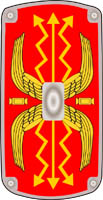


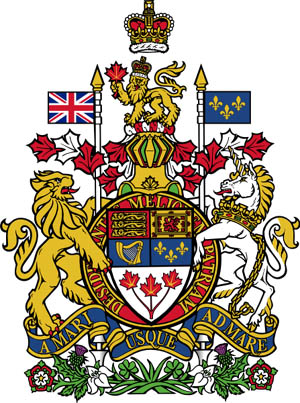

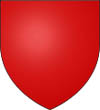




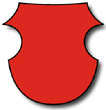
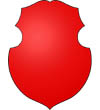
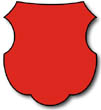


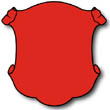
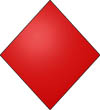

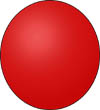
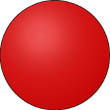
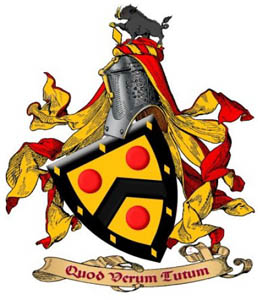
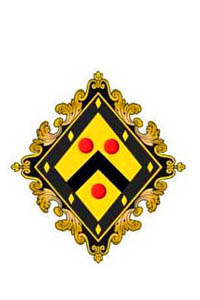
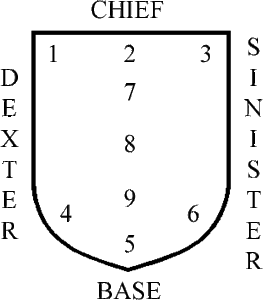



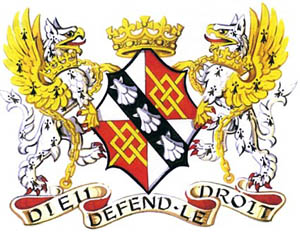
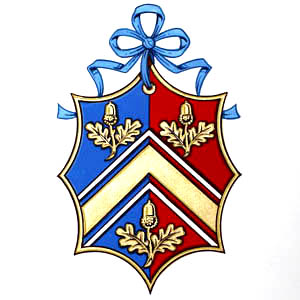
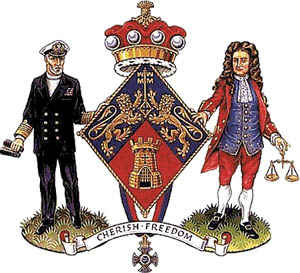









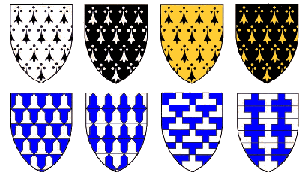
 Sanguine
(blood-red)
Sanguine
(blood-red)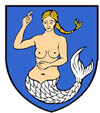
 Heraldry
is essentially a system of identification, so the most important
convention of heraldry is the rule of tincture. To provide for contrast
and visibility, metals must never be placed on metals, and colours
must never be placed on colours.
Heraldry
is essentially a system of identification, so the most important
convention of heraldry is the rule of tincture. To provide for contrast
and visibility, metals must never be placed on metals, and colours
must never be placed on colours. 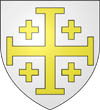
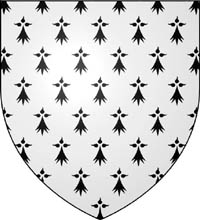

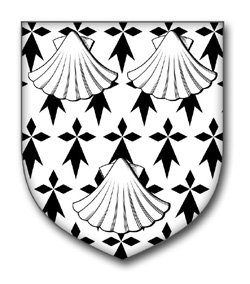


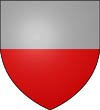
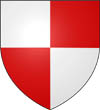
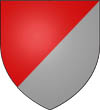
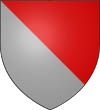
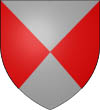
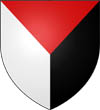
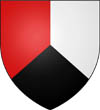
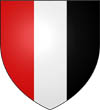
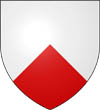

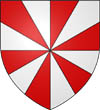
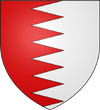
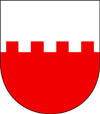
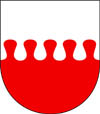
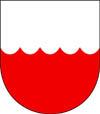
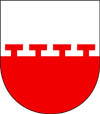
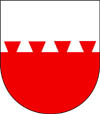
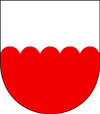

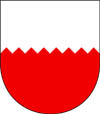
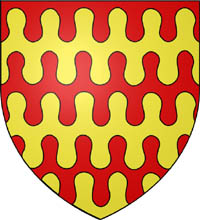
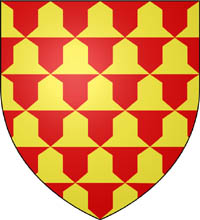
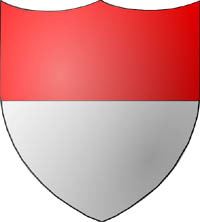
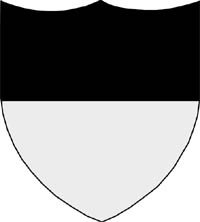

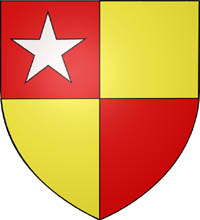
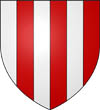
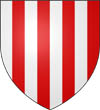
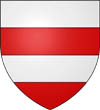

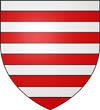
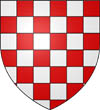
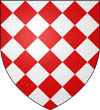
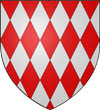
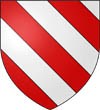

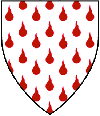
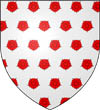
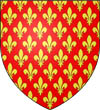
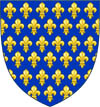
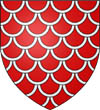
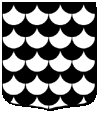
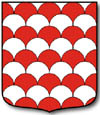
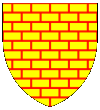
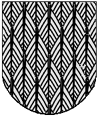
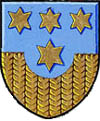
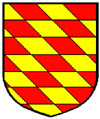
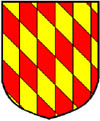
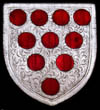
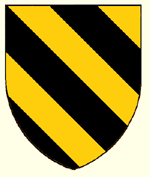

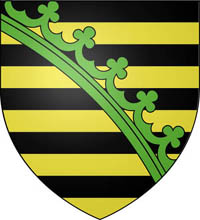
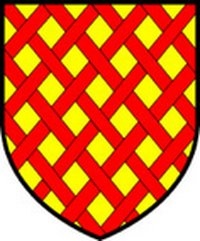
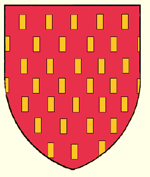
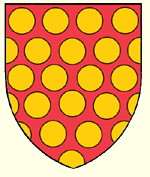
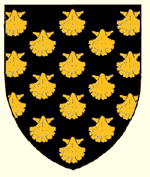
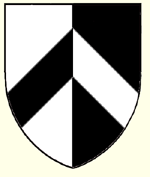






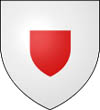



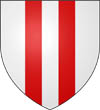
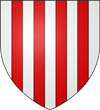


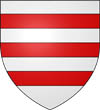
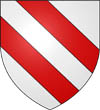
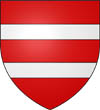
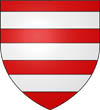
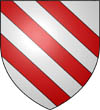
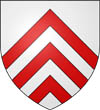
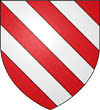
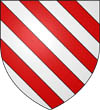
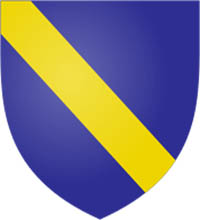
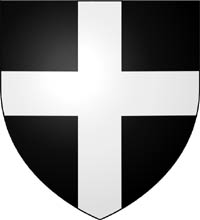
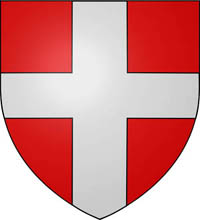
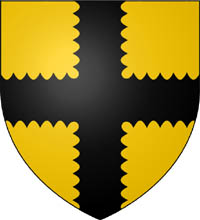
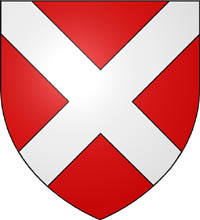
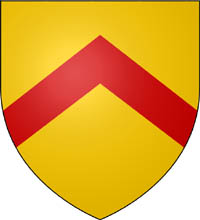
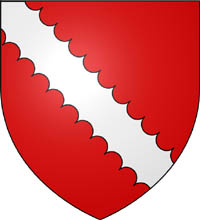
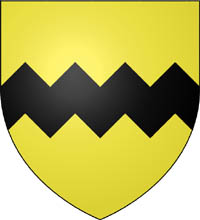
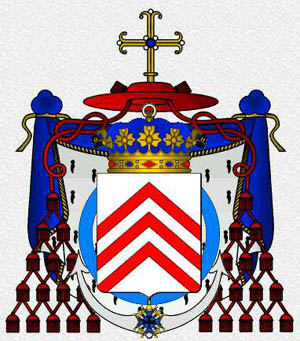

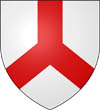
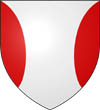
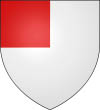
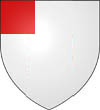
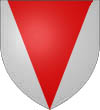

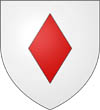
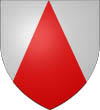
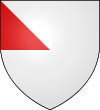
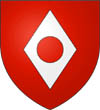
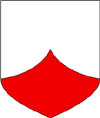
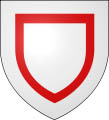
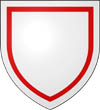
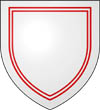

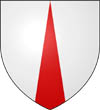
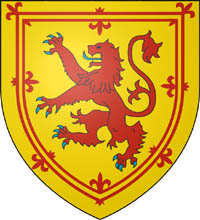
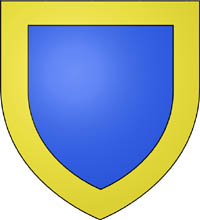

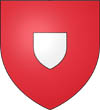
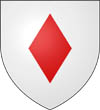

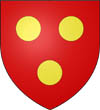

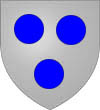
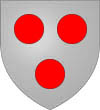

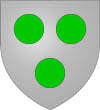
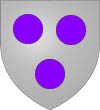
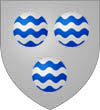
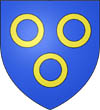
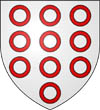
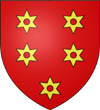
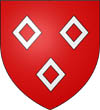

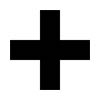
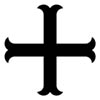
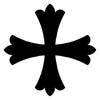
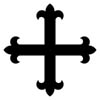
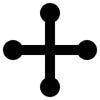
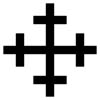
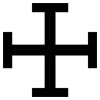

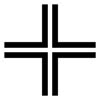
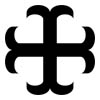
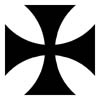
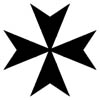
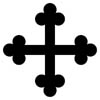
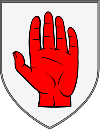
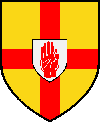
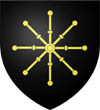
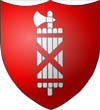
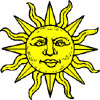

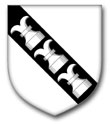 As
an ordinary
As
an ordinary 

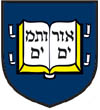


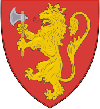





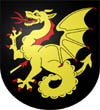
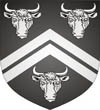
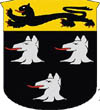
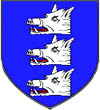
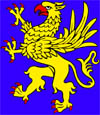
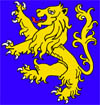
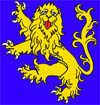
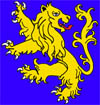
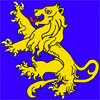
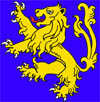


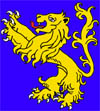



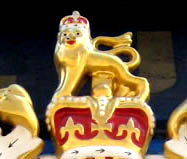


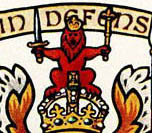
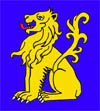




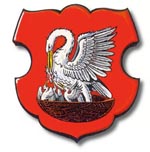 One
peculiar attitude among birds, reserved only to the pelican, is
the pelican in her piety (i.e. wings raised, piercing her own breast
to feed her chicks in the nest). This symbol carries a religious
meaning, and became so popular in heraldry that pelicans rarely
exist in heraldry in any other position. A distinction is observed,
between a pelican "vulning herself" (alone, piercing her
breast) and "in her piety" (surrounded by and feeding
her chicks).
One
peculiar attitude among birds, reserved only to the pelican, is
the pelican in her piety (i.e. wings raised, piercing her own breast
to feed her chicks in the nest). This symbol carries a religious
meaning, and became so popular in heraldry that pelicans rarely
exist in heraldry in any other position. A distinction is observed,
between a pelican "vulning herself" (alone, piercing her
breast) and "in her piety" (surrounded by and feeding
her chicks).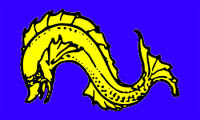


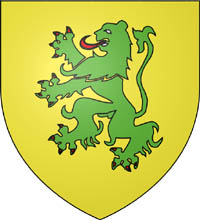
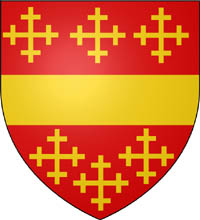

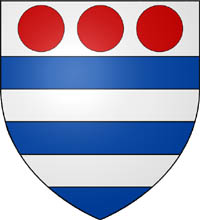
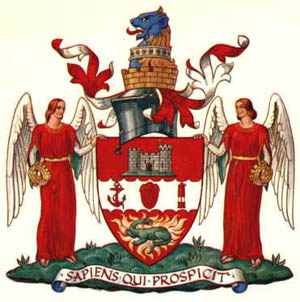
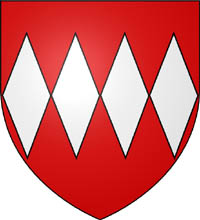
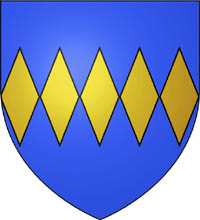
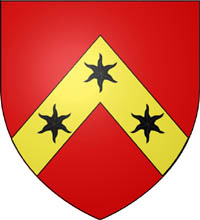
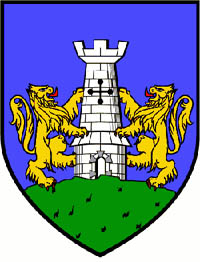

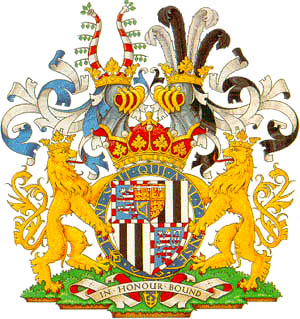
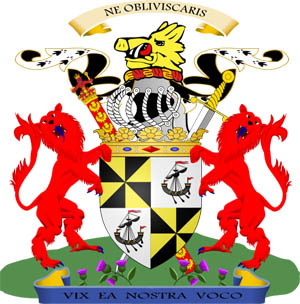


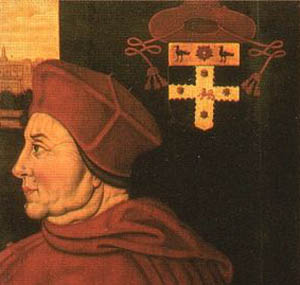
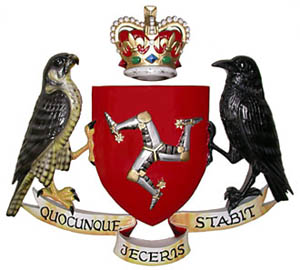

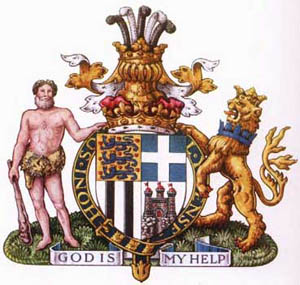
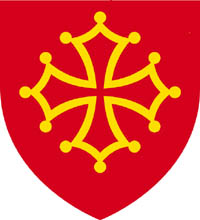
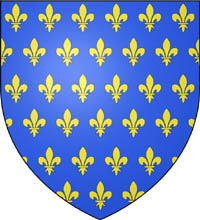
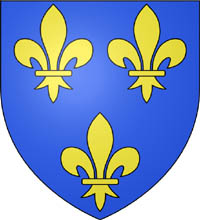
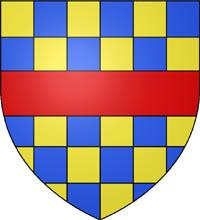


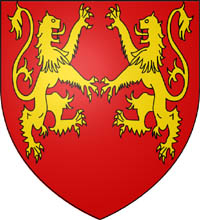
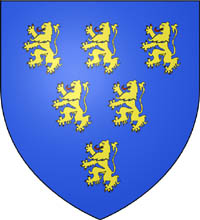
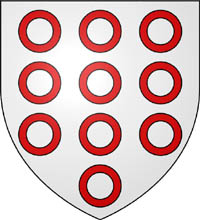


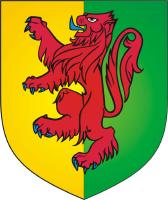

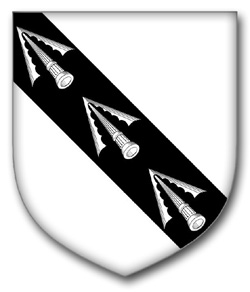
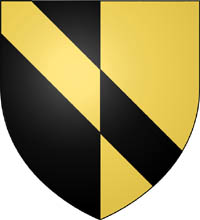
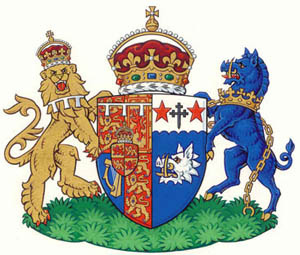
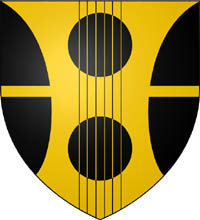
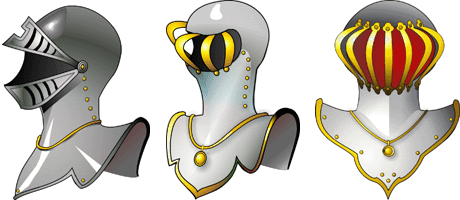

 The
earliest heraldic crests were apparently painted on metal fans,
and repeated the coat of arms painted on the shield, a practice
which was later discontinued. Later they were sculpted of leather
and other materials.
The
earliest heraldic crests were apparently painted on metal fans,
and repeated the coat of arms painted on the shield, a practice
which was later discontinued. Later they were sculpted of leather
and other materials. 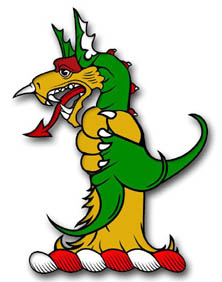 Crests
are occasionally humorous. On the left is the crest of Beet of Chester
Crests
are occasionally humorous. On the left is the crest of Beet of Chester
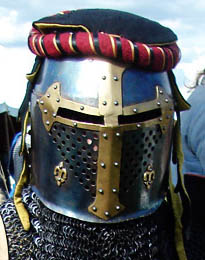
 The
crest is usually found on a wreath of twisted cloth and sometimes
within a coronet. It normally has six twists of material with the
metal and colour alternating from Dexter to sinister and with the
metal first.
The
crest is usually found on a wreath of twisted cloth and sometimes
within a coronet. It normally has six twists of material with the
metal and colour alternating from Dexter to sinister and with the
metal first.
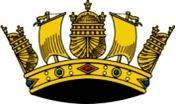
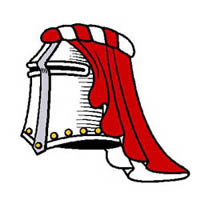 Mantling
Mantling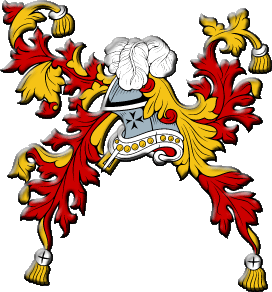
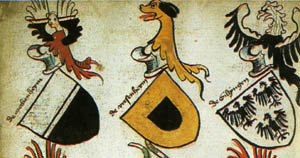
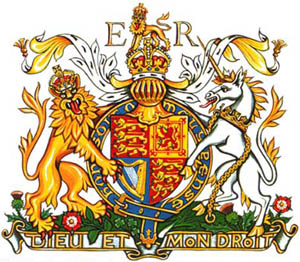

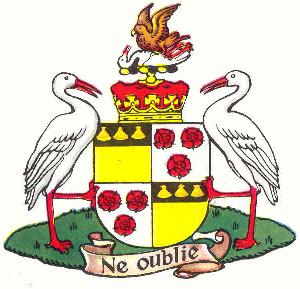
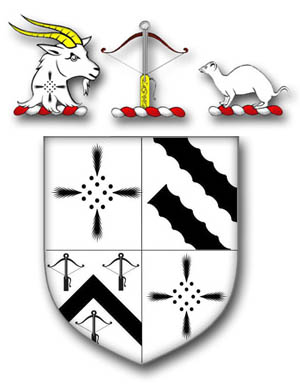
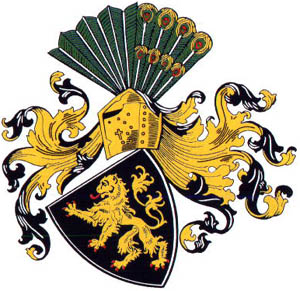
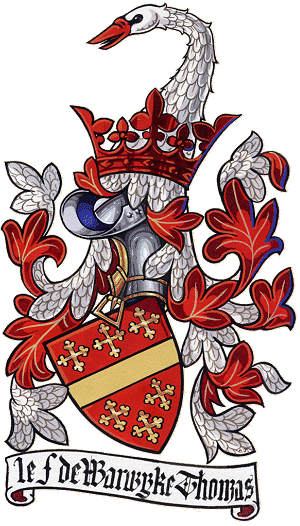
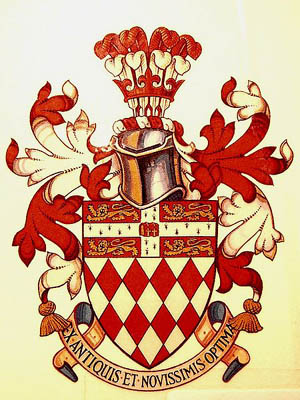
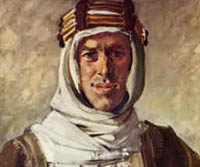

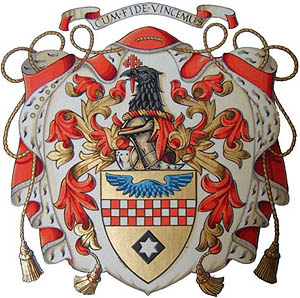


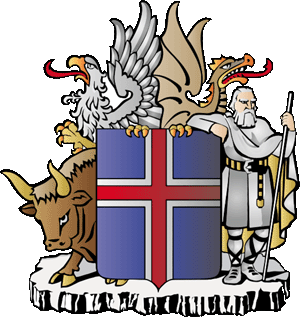 Animal
supporters are by default as close to rampant as possible if the
nature of the supporter allows it (this does not need to be mentioned
in the blazon), though there are some blazoned exceptions. An example
of whales 'non-rampant' is the arms of the Dutch municipality of
Zaanstad.
Animal
supporters are by default as close to rampant as possible if the
nature of the supporter allows it (this does not need to be mentioned
in the blazon), though there are some blazoned exceptions. An example
of whales 'non-rampant' is the arms of the Dutch municipality of
Zaanstad.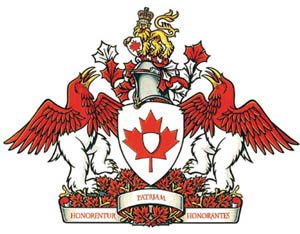 Non-hereditary
supporters are granted to life peers, Knights and Ladies of the
Order of the Garter and Order of the Thistle, and Knights and Dames
Grand Cross of the Order of the Bath, Order of St Michael and St
George, Royal Victorian Order, and Order of the British Empire.
Knights banneret were also granted nonhereditary supporters, but
no such knight has been created since the time of Charles I. Supporters
may also be granted to corporations which have a Royal charter.
Non-hereditary
supporters are granted to life peers, Knights and Ladies of the
Order of the Garter and Order of the Thistle, and Knights and Dames
Grand Cross of the Order of the Bath, Order of St Michael and St
George, Royal Victorian Order, and Order of the British Empire.
Knights banneret were also granted nonhereditary supporters, but
no such knight has been created since the time of Charles I. Supporters
may also be granted to corporations which have a Royal charter.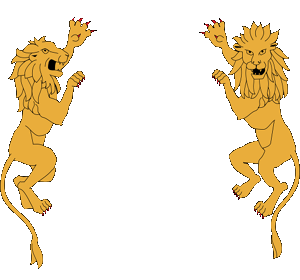
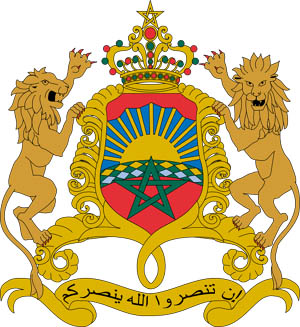
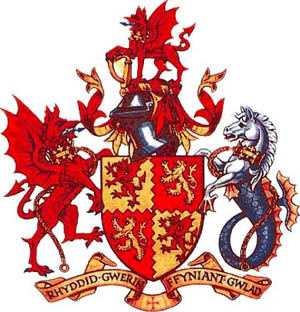

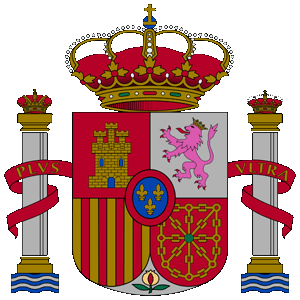
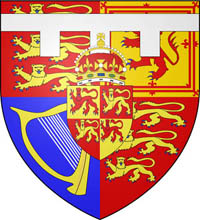
.jpg)
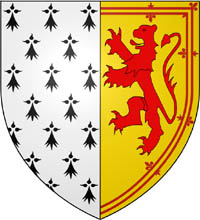
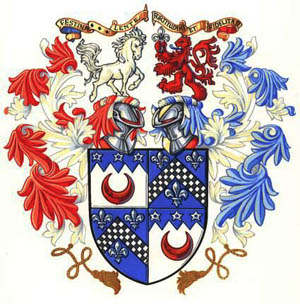
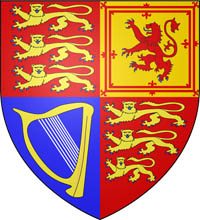
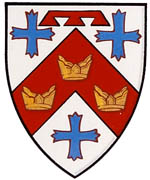 for
the first son, a label of three points (a horizontal strip with
three tags hanging down)—this label is removed on the death
of the father, and the son inherits the plain coat;
for
the first son, a label of three points (a horizontal strip with
three tags hanging down)—this label is removed on the death
of the father, and the son inherits the plain coat; 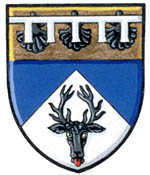
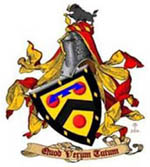
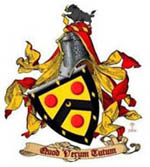
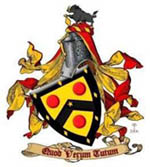
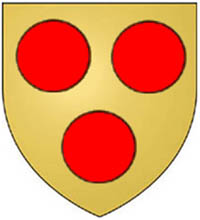
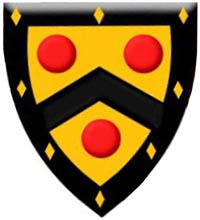
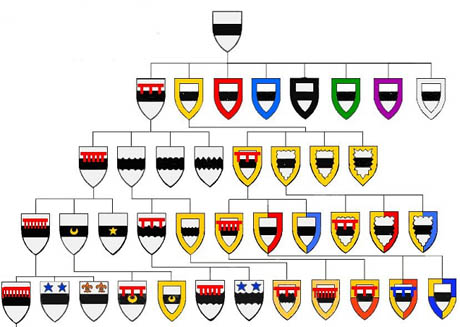

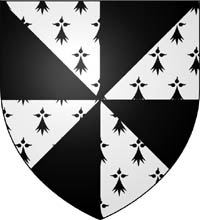
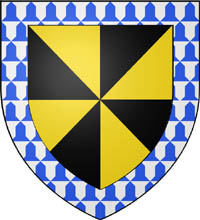
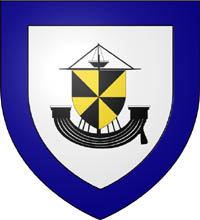

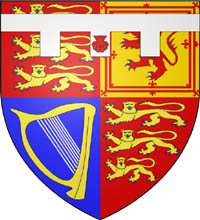
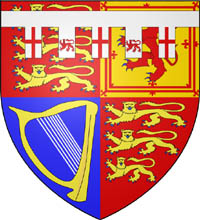
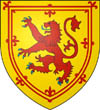
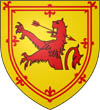
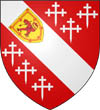
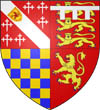
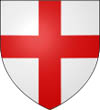


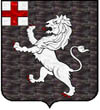
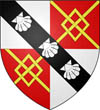
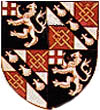
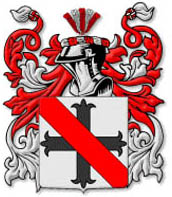
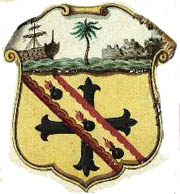 Admiral
Nelson started off with a simple coat of arms which acquired two
separate augmentations of honour which rather destroyed its simple
elegance.
Admiral
Nelson started off with a simple coat of arms which acquired two
separate augmentations of honour which rather destroyed its simple
elegance. 
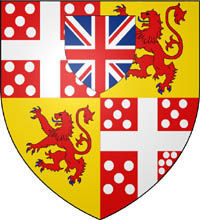
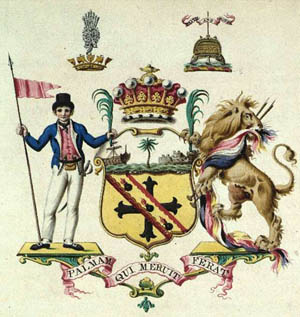
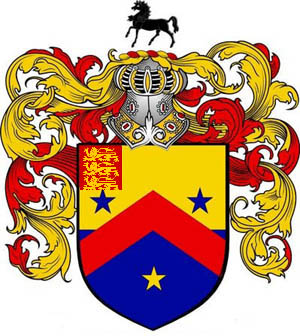

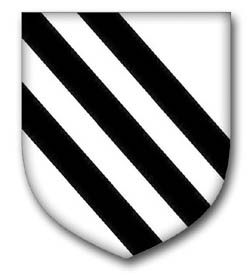
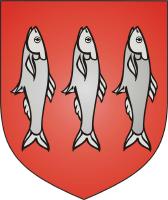
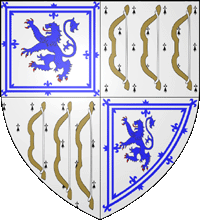
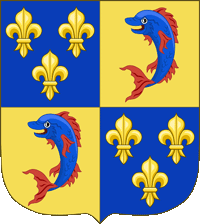

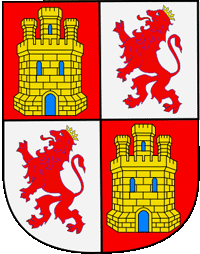
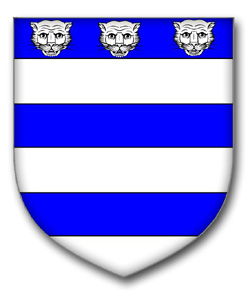

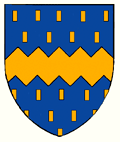
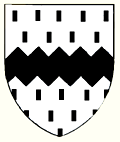
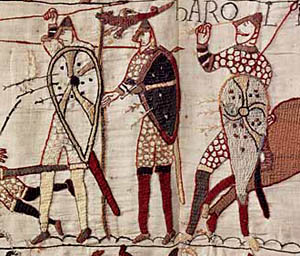
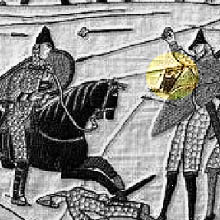


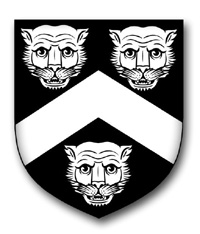
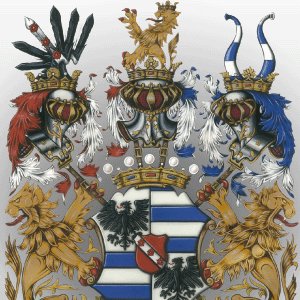



 Military
heraldry continues developing, incorporating blazons unknown in
the medieval world. Nations, provinces, states, counties, cities,
etc. continue building upon the traditions of civic heraldry. The
Roman Catholic Church, the Church of England, and other Churches
maintain the tradition of ecclesiastical heraldry for their high-rank
prelates, religious orders, universities, and schools.
Military
heraldry continues developing, incorporating blazons unknown in
the medieval world. Nations, provinces, states, counties, cities,
etc. continue building upon the traditions of civic heraldry. The
Roman Catholic Church, the Church of England, and other Churches
maintain the tradition of ecclesiastical heraldry for their high-rank
prelates, religious orders, universities, and schools.

